#they are important and show various parallels and foreshadowing
Explore tagged Tumblr posts
Text
KH3 Worlds ACTUALLY Matter and show Major Parallels and Foreshadowing through Sacrifice and Separation
The worlds in KH3 are often seen as just retelling of the Fairytales but with added Sora and his friends or Organization members. Because of this they're often disliked especially when there are some sections that are scene for scene and Sora and the others might not be present for this.
However, if you get passed the fact it's a retelling of the movie and get into how it connects with Kingdom Hearts story, they actually play a major role.

Olympus: Sacrifice
Olympus shows themes of sacrifice and love. It shows that Hercules didn't think and all he knew was that Meg was in trouble and threw himself in harm's way to save her. He sacrificed himself by doing that but also sacrificing his godhood to be with Meg. He would have to be separated from Meg and that's not the kind of life he would want to live.
Later on Riku ends up doing the exact same thing. When Sora feels powerless and all alone he sacrifices his being and life for Sora. And I could also argue he does it out of love because when he does this he doesn't necessarily think of his actions but does it to his devotion to Sora and protecting him like he always promised Terra.
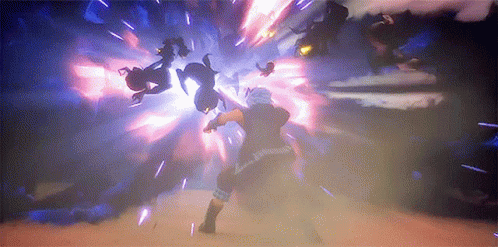
Corona: Sacrifice
In the Tangled world, Rapunzel is willing to sacrifice her freedom to save Flynn's life and become separated from the outside world she's grown to love forever.
However, Flynn decides that her freedom is more important and sacrifices himself by cutting her hair which could make her lose the power to heal.
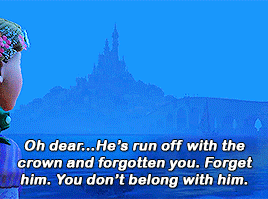
Rapunzel is also compared to Riku because they both so desperately felt trapped. Riku felt trapped at the island and wished to leave and explore other worlds with Sora and Kairi to point where if the raft didn't work out, he would open the door to darkness. I'll also like to include they both felt that someone they were close to left them for others.
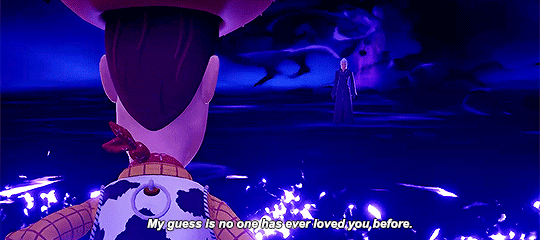
Toy Box: Separation
In Toy Box, we learn of how Woody and Buzz among a few other had separated from half of their group. However, they are later seen that the world was split in half and are separated from their beloved friends. They realize at the end their friends who they've been separated from that they are always connected through their hearts.
And this goes back to how Sora will soon be separated from everyone and become stuck at the Quadratum. It also shows that he is always connected to them through his hearts and that's how he uses/and abuses the power of waking through that connection.
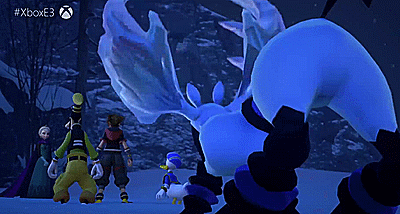
Arrendale: Sacrifice
When Elsa is about to get slashed by Hans' sword, Anna who is in the brink of death rushes in and saves her by taking the hit instead. She freezes at the same time and makes it so the sword shatter from her entire body becoming ice. She sacrifice her life for her. Elsa manages to thaw her and the cold weather by the act of love.
Which Riku then does the act of love when he sacrifices his life for Sora. Riku is also compared to Elsa on how they both pushed the people they loved/ cared about away to protect them.
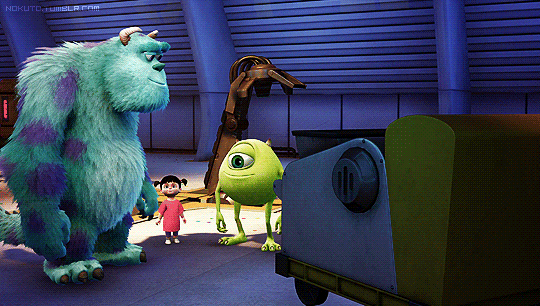
Monstropolis: Separation
In this world, Sullie goes through separation of being away from Boo. They have to separate so Boo will be safe.
This also refers to how Sora ends up in the Quadratum from bringing back Kairi and abusing the power of awakening by using it too many times.
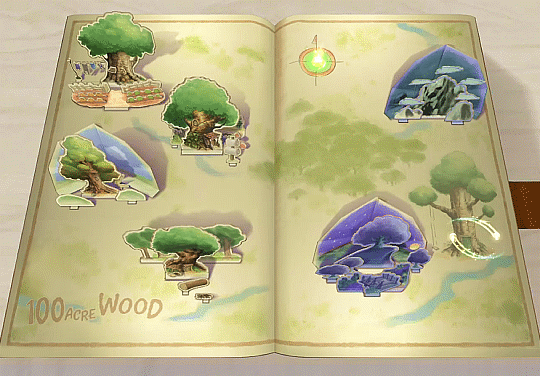
100 Acre Woods: Separation
In this world, Pooh talks to hope they're growing apart and that he misses Sora. Sora feels sad that they're not as close. The eventual outcome is that he'll always be in his heart no matter what.
I feel like this refers to him and Kairi not being as close as they were before. Ever since KH1 things changed between them and she changed. She's no longer the Kairi he knew and they are slowly growing apart. (Which is honestly sad). It also shows that even if he's by himself in the Quadratum he'll have everyone in his heart no matter how far away they are.
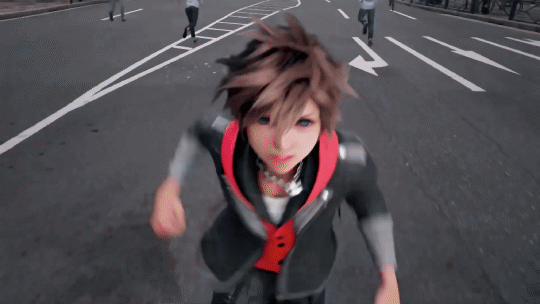
Fransankyoto: Separation + Sacrifice
Unlike the others I decided to say this world shows both. In the past, Hiro's brother separated from him when he sacrificed himself to try to find and save the teacher. This is also reflected in the past when beymax also stays behind to sacrifice himself so Hiro can then leave.
It helps shows the connections that no matter how far they are away, the people you love and care for will be in his heart. This shows that to help save everyone he used his connection to his friends to bring them that. It furthers that he won't be alone in the Quadratum and that Riku was able to go to him in MOM because of this.
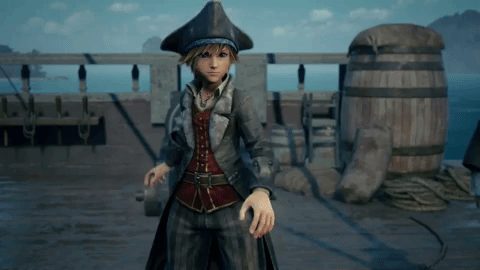
PoTC: Separation
Finally in the pirates world, we show separation. After Will gets stabbed and he is made Captain of the Flying Dutchman, he faces separation from the one he loves Elizabeth. Only every 10 years are they able to see each other.
This foreshadows both being separated from the ones Sora loves and bringing back all his friends' hearts when Will's life almost gets taken when he gets stabbed. Being apart for 10 years also could lead to how it will take at least a year to find Sora in the Quadratum.
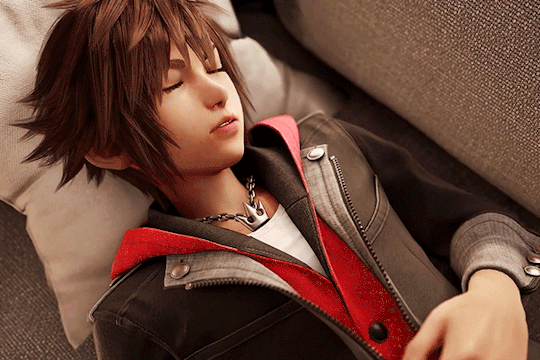
#kingdom hearts#soriku#riku#sora#kh analysis#kingdom Hearts 3#kh3#discussion post#analysis#kh parallels#kh foreshadowing#kh worlds#there is so much foreshadowing towards their separation#and the parallels between the other games#showing that riku sacrifices himself because he wasn't thinking and he just knew he loves Sora#as Hercules said#sacrifice foreshadowing#yeah Disney worlds matter#they are important and show various parallels and foreshadowing
75 notes
·
View notes
Text
Omega and Crosshair's story in The Bad Batch season 3 mirrors Hunter and Omega's story in The Bad Batch season 1, but with Omega taking on Hunter's role and Crosshair taking on Omega's.
Something the show did really well in season 3 was prove just how far Omega has come, and how she's become so much like all her brothers in different ways. Personally, I see a lot of Hunter in her, mainly for the way she's always tried to emulate him ever since season 1. That's what started to lead me on this path to discovering that, in season 3, she takes on Hunter's previous role from season 1, especially where Crosshair is concerned.
As always with any analysis, this is a disclaimer that you may view these episodes in an entirely different way due to various biases, one of the most notable being based upon your own favorite characters and your own life experience. All I ask is that you read through carefully before chiming in with any counterarguments!
The basis of this analysis, or at least what clued me in to this, are these two moments, and the similarities of the stories Hunter & Omega and Omega & Crosshair have in seasons 1 and 3, respectively.
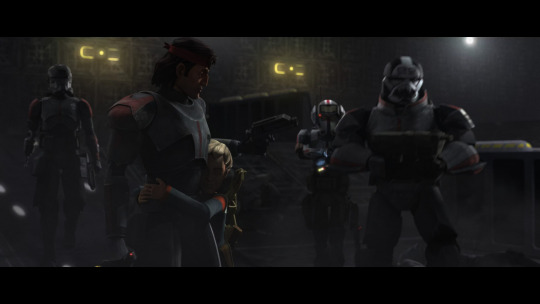
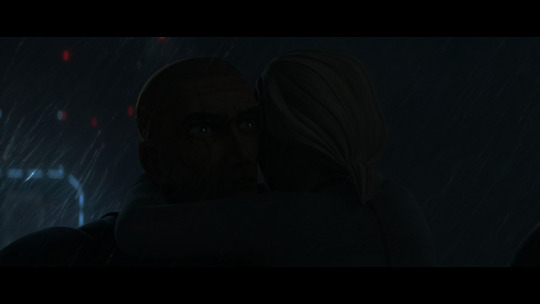
It's important to note straightaway that these two stories do not line up exactly the same. There are, rather, thematic similarities, and enough potential parallels that bring everything together just enough to show us how everything falls into place and brings season 1 full circle in season 3.
At the beginning of season 3, Omega and Crosshair are both imprisoned in the same place. Regardless, they're both being treated very differently. Omega has more of an illusion of freedom in having time on her own while she tends to her tasks. Crosshair, on the other hand, is either held in his cell or is actively being tortured/conditioned.
Metaphorically, this was also where Hunter (and the rest of the Batch) and Omega were in season 1, too. Hunter and the boys had the illusion of freedom in getting to leave Kamino and participate in missions, but they still had a duty to serve the Republic with no real choice ever being presented. Omega, on the other hand, was confined to Kamino, even kept hidden for the most part as Nala Se's lab assistant.
The dynamic between Omega and Crosshair shifts when Omega gets older. As I pointed out in this analysis, Omega's growth, and her shift into the role of Hunter, is made evident through the use of shadows when she talks to Crosshair in his cell. When she's younger, she looks as if she has Crosshair's marksman tattoo. When she's older, the left half of her face is concealed in a shadow, like Hunter's skull tattoo.
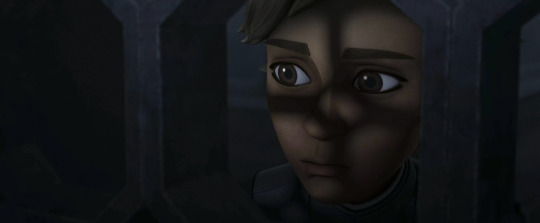
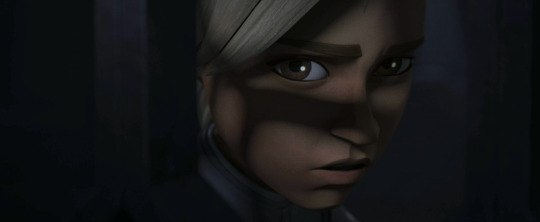
While this is showing Omega's growth by taking her from emulating the youngest of the Batch to the oldest, it's also foreshadowing how Crosshair is going to be taking on younger Omega's role, too.
It kicks off the strongest in episode 3, when it's time to make their escape. Omega insists on freeing Crosshair and taking him with her, despite him telling her that she should've left him behind—and that he wouldn't have thought twice about leaving her behind, either. But Omega refused to leave him behind. Why?
She's one of us. We're not leaving her there.
She learned that lesson from Hunter, who brought his entire squad back to Kamino just to free her from where she was being confined. Omega, now embodying Hunter's role, does the same for Crosshair here. She takes the risk to come free him and to make their escape together.
From then on, Omega actually calls a lot of the shots, if not all of them. Like Hunter, she's the strategist, guiding Crosshair but also considering and listening to his insight. Crosshair obeys, albeit more reluctantly than Omega used to obey Hunter—although she still used to protest if Hunter was sidelining her for her protection, so there are a few little similarities there.
(I would be remiss not to note here that the only glimpses we really get of Omega being a child again rather than the leader she learned to be from Hunter is when she's actually with Hunter. The face she makes when she runs to him during their reunion, melting into his embrace, snuggling Lula on the Marauder, leaning her head on his shoulder on Pabu... he's the safe space where she can fully relax and just be a kid again, because even if she's always gonna be Hunter for others, he's the only Hunter for her.)
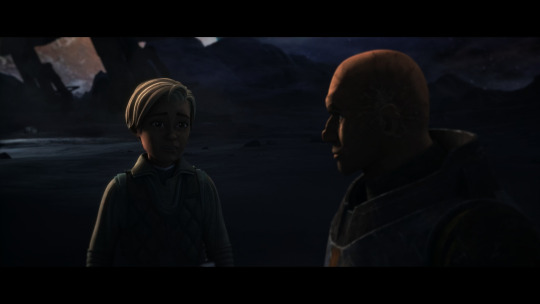
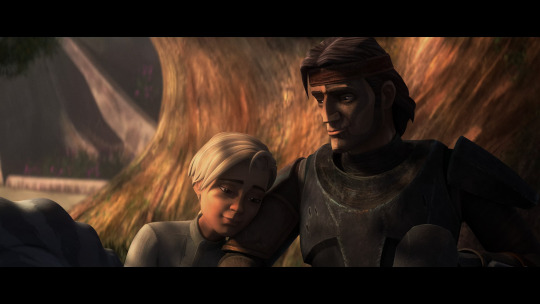
After the reunion, we see Crosshair struggling at first to be back with his squad as their new history stands between them, mostly due to Crosshair's own guilt and hesitance and Hunter's desire to learn more and understand what happened. Because of their issues, Hunter doesn't have the established trust he needs yet to help Crosshair the way Omega can. That's why Omega, in a way, takes on the role Hunter used to have in Crosshair's life—at least, in this season.
Omega is very protective of Crosshair during this time, in a way that's reminiscent of how fiercely protective Hunter always has been of Omega. Of course, Crosshair is also very protective of Omega, too, and we also saw this with Omega regarding Hunter (and the others) in season 1. She was constantly worried about them when they were on missions without her, and that relieved way she says Hunter's name when she realizes he's alive after his shootout with Cad Bane will always get me.
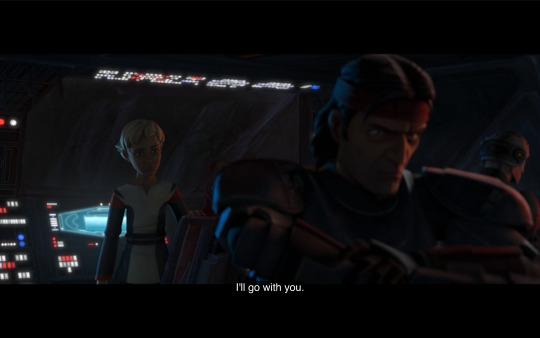
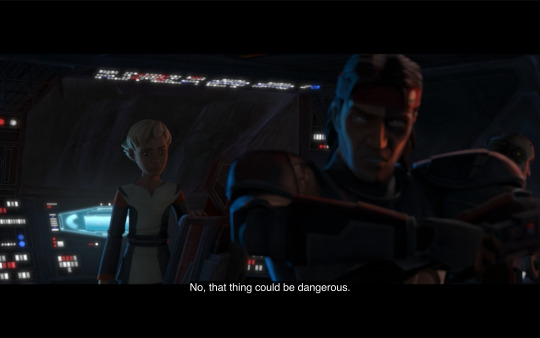
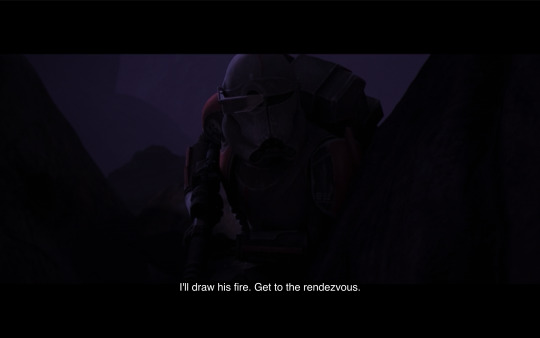
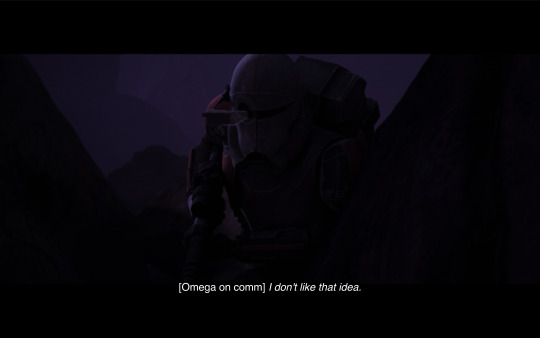
The biggest thematic similarity between season 1 Omega and season 3 Crosshair, however, is their motivation, as far as the rest of the squad is concerned. Omega tries her hardest to earn their trust and their approval by training with her bow, strategizing, following orders, and more. Crosshair wants the same thing; he wants to regain the trust and approval he had from his brothers before everything happened. He practices shooting with his rifle and is frustrated when he can't protect them the way he wants to.
Just as Omega's past haunted her in the form of bounty hunters throughout season 1, Crosshair's past haunts him in the form of his hand tremor and CX-2. Omega's worst fear became returning to Kamino, and Crosshair's is returning to Tantiss. This is what they're trying to run from the entire season, despite the fact that all paths start to lead right back to those places.
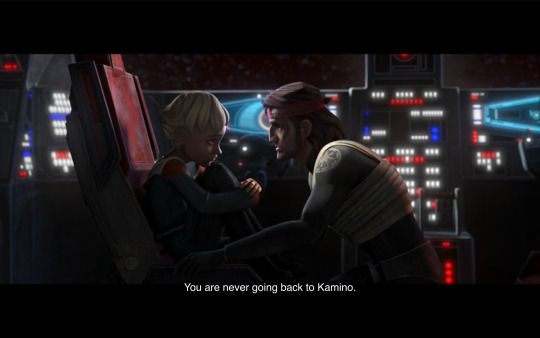
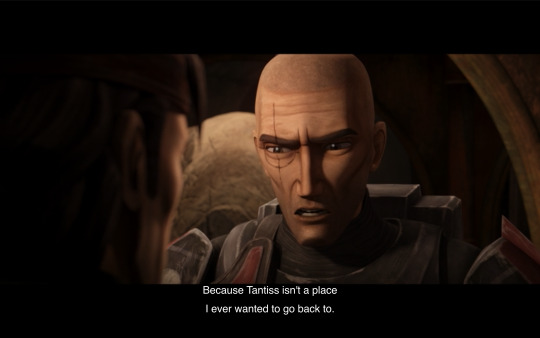
Eventually, the Empire becomes a threat again, and escape becomes impossible for season 1 Hunter and season 3 Omega, respectively. Both of them give themselves up to protect others. Hunter orders Tech to leave him on Daro, while Omega insists on turning herself in to protect Pabu and her brothers. They both do so without fear, intent on either getting themselves out of their situation or depending on their squad to help them.
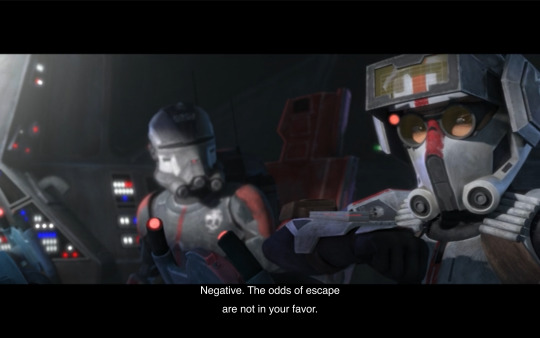
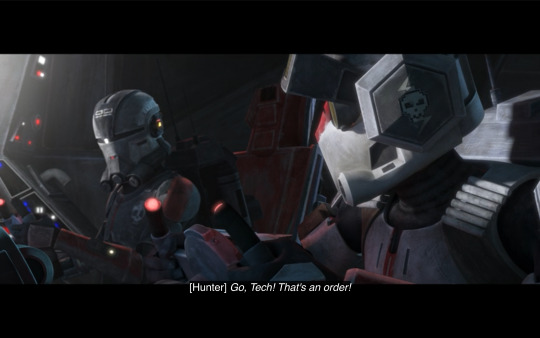
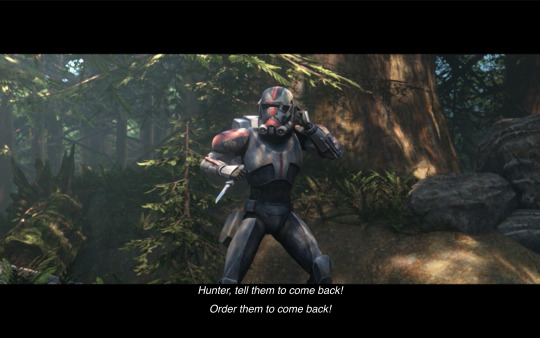
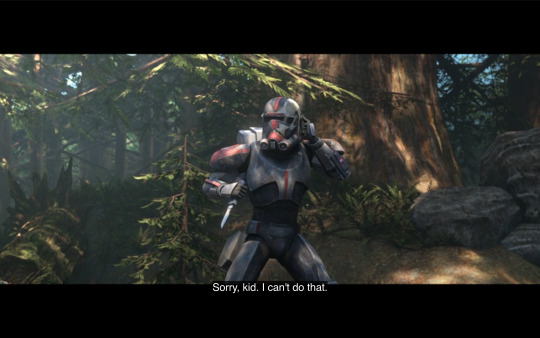
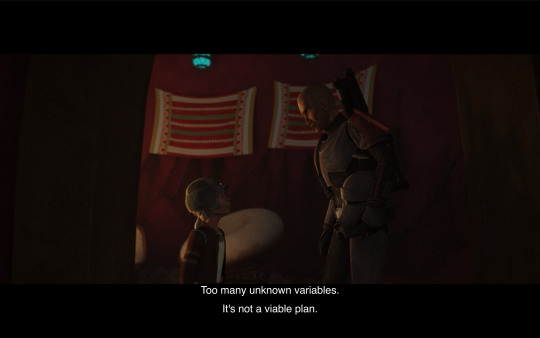
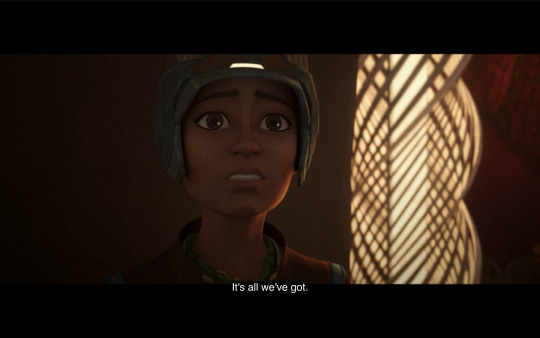
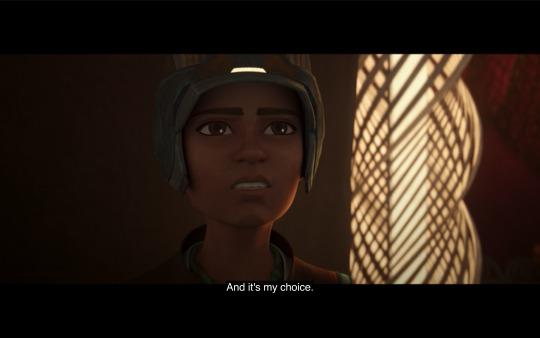
(Crosshair technically substituting for Tech here, too... I'm emotional.)
This is when we get the pinnacle of season 1 Omega's and season 3 Crosshair's arcs: they go back to the place they fear the most solely for the sake of their Hunter-figure. This action alone proves the growth they've done over the course of the story, as the trust, connection, and love they truly, deeply have for that person they look up to encourages them to be brave and to face their greatest fears to save them.
Season 1 Omega returns to Kamino for Hunter, and season 3 Crosshair returns to Tantiss for Omega. We all know that Omega is exhibiting peak Hunter behavior here as she looks after the younger children imprisoned with her to help them escape, but that's beside the point currently. We fast forward to their reunions, when the immediate threat is gone and the Hunter-figures realize what their Omega-figures sacrificed to save them.
Not only that, but they're also reminded that it was because of their own initial actions that the Omega-figures found the bravery and inspiration to conquer their fear. Season 1 Omega reminds Hunter that he had gone back to Kamino for her first, and season 3 Crosshair doesn't have to say anything for Omega to remember the way she risked her own escape attempt to free him from his cell first. They never gave up on each other.
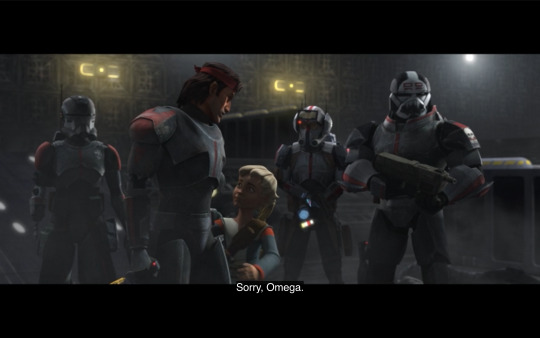
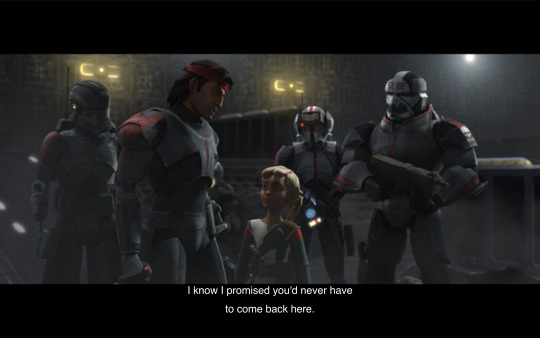
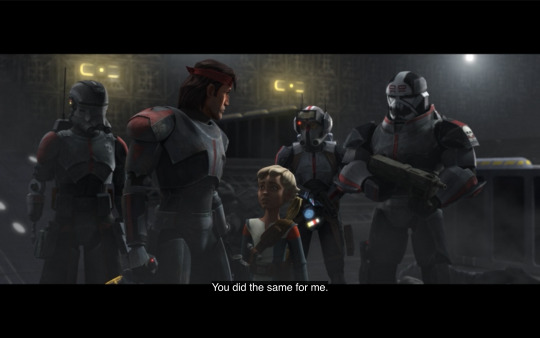
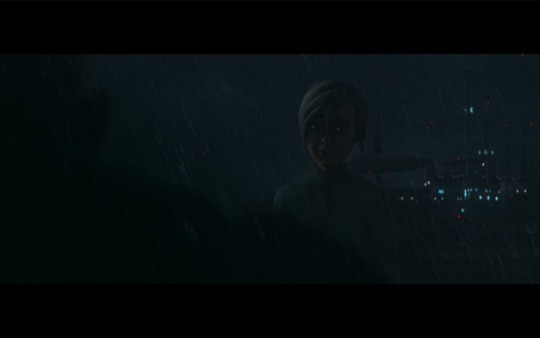
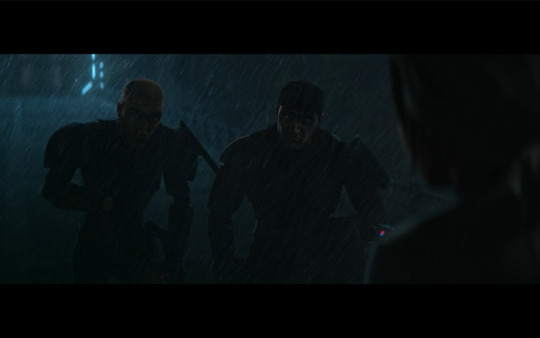
I, of course, don't miss the significance of Hunter being in the latter scene when this all happens. Again, while Omega may act like Hunter to many others, only Hunter himself can take on that role in her own life. Here, Hunter gets to see how his actions when they first took in Omega have influenced her and, now, his youngest brother. It's such a heartfelt and rewarding full-circle moment, with Omega being the mend between these two formerly torn-apart brothers. It's such a large step ahead from where they were before.
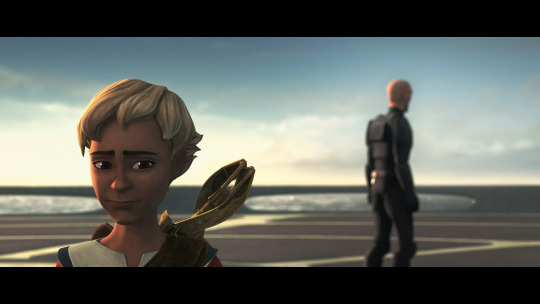
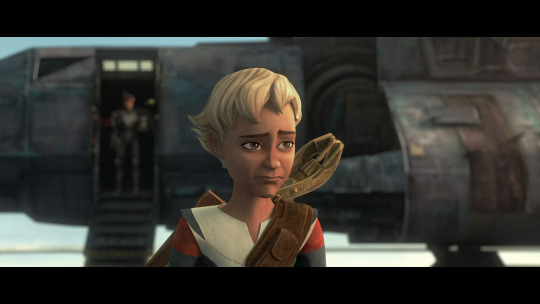
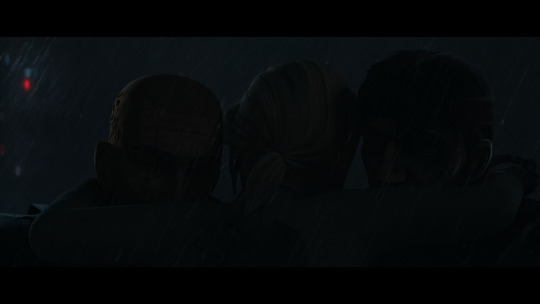

The epilogue essentially becomes a lighthearted display of the similarities between Hunter and Omega. He stresses that he and his brothers want to keep her safe, and after reassuring him that she will be, she asks him to look over their other two brothers—proving that both of them are still protective as Hunter-figures over those they see as their Omega-figures. All the while, of course, they're protective over one another, too, even if it goes without saying.

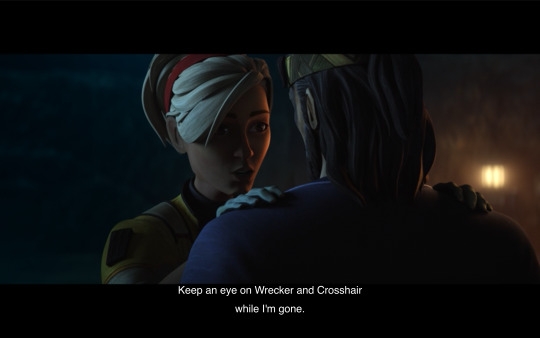
Essentially, Hunter became who he had to be to take care of Omega, and Omega followed that example to take care of Crosshair. This is, in my opinion, probably why we didn't get as much Hunter and Omega in season 3 as we did Crosshair and Omega, but not for the reason many may think. It was because Omega was already in Hunter's role, and Crosshair was in Omega's role.
It's really sweet to see how full circle the story has come from season 1. Crosshair is getting the treatment and attention Omega got in season 1, but he's getting it from Omega herself, because that's what Crosshair really needed. Hunter couldn't be in that role anymore because of their own hurt—plus, their relationship is just different. Instead, we get to see what Omega learned being passed on as she grew, and how it ultimately helped to heal Crosshair and the rest of them.
If you enjoyed this analysis, here are some other ones I've done:
Hunter and Crosshair in "The Return"
Crosshair taking the shot in "The Calvary Has Arrived"
#omega becoming like hunter is just everything to me okay???? okay!!!!#tbb omega#tbb crosshair#tbb hunter#the bad batch#star wars#the bad batch meta#star wars meta
116 notes
·
View notes
Text
i know that anyone who can read already knows about the parallels between stsg and Megumi+Yuuji but i'm gonna gush anyways
Yuuji and Megumi's thematic and narrative roles where narrative is the metatextual story of jjk being the same as Gojo and Geto where Yuuji=Gojo and Megumi=Geto
but their narrative roles where the narrative is in universe fate and the concept of things happening for a reason and mattering as relates to Yuuji's and to a certain extent Geto's world views are reversed. Yuuji=Geto and Megumi=Gojo
and then my sleep deprived brain just started listing things in no particular order so imma put that mess under the cut
-yuuji + geto eat curses (if i wasnt lazy and sleep deprived i would put in geto's various monologues about his thought process when eating curses here)
-megumi + gojo's curse techniques are directly compared in universe (the two strongest- meaning that gojo talking about the limitless/six eyes + ten shadows fighting each other to stalemate in the past was foreshadowing the gojo sukuna fight now that i think about it )
-yuuji and gojo personalities and coping mechanisms paralleled-- their bubbly happy personas are a mask for their more selfish/angry true personalities but most importantly for their loneliness (the most important part of both character's themes in different ways but that's a whole other rant)
-megumi and geto similar personalities + relationships to y+g= grounding/semi rivals/antagonistic but caring friends
-everyone(in universe) thinks that gojo and yuuji are ticking time bombs that will inevitably cause untold horrors but it turns out that they.. just dont in not insignificant part due to words dissuading them from that ledge said by their other halves (megumi tells yuuju to "save [him]" + geto changing gojo's entire outlook on the world in their conversation when reuniting after toji's defeat)
-everyone(in universe) thinks that megumi and geto are relatively sane but their sanity is more fragile than it seems (geto is self explanatory but for megumi see the fight where he first uses chimera shadow garden and how quickly he gives up completely after his sister gets got) and both end up possessed by one of the series main two villains
-but also yuuji + geto's originally stated motivations for becoming jujutsu sorcerers are supposed to mirror each other-- yaga's whole speech to yuuji when they first meet is everything he wishes he could have said to geto before he went crazy
-their connection to the two main villains of the series (sukuna + 'fake geto')
--geto and yuuji are heavily connected to 'fake geto' for both obvious and spoiler reasons
--megumi and gojo are connected a lot to sukuna - gojo is compared to sukuna a Lot and sukuna shows interest in megumi multiple times + more spoiler stuff (((sorry anime onlys)))
ouch head hurt
#tldr ->#megumi is what if gojo was geto#yuuji is what if geto was gojo#“if i could become you”#jjk#jujutsu kaisen#jjk spoilers#sorry this is incomprehensible#sometimes i write posts just for me
10 notes
·
View notes
Text

YOU ASKED AND SO I SHALL DELIVER!!
ʚ♡ɞ
I was discussing with a few friends how Of Mice and Men keeps being removed from American school curriculums and banned by various school administrations throughout the states for ‘vulgar language, using the lord's name in vain’ and so on, but primarily about how it was banned for containing ‘racism, misogynistic, and potentially offensive to those with mental disabilities’.
But that's the most fundamental point of the entire book. To show the prejudices that the characters on the ranch experienced and the importance of companionship. I found a whole list online about it, it’s super fascinating seeing just how harshly it is challenged. You can find it here, but I'll post screenshots of the list below:



When I say that the misogynistic and especially racist themes are ‘there for a reason’, that’s not to say that I believe it should be completely brushed over because it is still a fundamental part of the novel that shows a lot regarding the historical and social context which it was written in and about life of Americans during the Great Depression beyond just white able-bodied men and how it should be handled in modern society rather than completely brushed under the rug
It’s awful seeing these painful but important parts of black American history and the treatment of black people in the past being completely glossed over and ignored just because people are ‘uncomfortable’ to discuss it when it’s so important to acknowledge it so we can learn from the last the same way that is done with white history.
Books such as Of Mice and Men are lumped in with hatred-driven racist/misogynistic/ableist drivel when its incredibly important to the time period it was written and should serve as an example of what not to repeat
A wonderful friend of mine said this which is definitely worth contributing:
'Something I remember is the very blatant connection between Lennie and the ranch dog. The ranch dog had nothing more to give after it reached its elderly years and it was suggested that he was to be shot. For the ranch, it had nothing of value to give once its strength was gone. Lennie, who had been compared to a dog a chapter (or more? it's been a while) prior to making it a little more obvious would eventually be the same because jobs in that time period did not accommodate disabilities, particularly Lennie's intellectual disability. They make it very clear that that's the climate they had been working with when they discussed putting the dog down. '
“I ought to have shot that dog myself, George. I shouldn’t have let no stranger shoot my dog.”
Lennie’s parallel with Candy's dog was so clever because it was wrong. Yes, it was foreshadowing what was going to happen to Lennie, yes it was setting up how George was to be the one who shot him because he didn’t want Lennie to die at the hands of a stranger scared and alone potentially like Candy’s dog was. Yes, Candy’s dog had nothing to offer the ranch anymore as it was so old and was ‘no good to himself’ and that’s why it was proposed to shoot him as a mercy.
But Lennie did have something to offer, he was strong and worked hard and efficiently. But he was just assumed to be useless to others because of his intellectual disability. Everyone just kept underestimating him and making incorrect assumptions about him and what he was capable of which Steinbeck intentionally included because he DOES show that the assumptions made are incorrect. Lennie was truly so much more than what other characters believed him to be.
That’s why the harsh banning of it was so ironic and disappointing. The boards of education who read it and still chose to ban it for ‘ableism and offending those with mental disabilities’ are the ones who are assuming that Lennie is just as incapable as every other character assumes him to be. Children could learn a lot from this book and the writing of it's characters, but instead it’s brushed over because it makes people ‘uncomfortable’ when really it’s something so important that should be discussed and if there really is a ‘problem’ with it, then instead of banning it, school boards should instead focus on how the sensitive subjects should be actually taught and addressed than ignoring it or banning it entirely.
Crooks’s identity as a black man is so fundamental to his whole character and the way he is taught about in schools is extremely reductive, completely disregarding the way he’s treated which is bewildering since he’s just as fascinating and fleshed out as every other character in the novel - He’s got personality expressed through how he communicates with Lennie and even more so his room, he has dreams even if he pretends otherwise and longs for companionship, and yet schools just gloss over him as a character and swap out the n word and pretends like the way he’s addressed is just mildly unfortunate because it was written when racism towards black people was ‘the norm’ which again is extremely reductive and children do not truly learn anything from it.
Every major character can be sympathised with one way or another, they’re all so incredibly fleshed out especially for the time it was written even if there are aspects that aren’t socially acceptable today, it contributes to the discussions we NEED to have about WHY we feel this way about the book, how far we have come since it's writing, acknowledging the past and how it’s handled in the modern day. There is SO much to be learnt beyond the story not only looking at language and story, but also the racial, biographical, historical and social context of the novel!!
all the characters are reduced SO MUCH in an educational setting. ‘Lennie is the dumb one. George is the smart one. Curley is the angry one. Curley’s wife is the slut. Slim is the handsome one. Crooks is the black one. Candy is the old one.’
It's SO much more than just ‘Steinbeck wrote a racist, misogynistic, ableist book.’ NO. He wrote a story about migrant workers trying to find work during the great depression. He wrote a story about an intellectually disabled man in an ableist environment. he wrote a story about a woman in a misogynistic environment. He wrote a story about a black man in a racist environment. He wrote about how that environment failed and abandoned them. He wrote about how this environment embodies the whole world of the time it was written. Regardless, they all have a uniting factor: they have a dream. The American Dream specifically. Each one of them hears Lennie and George's dream and they all want the same thing and all band together until it all falls apart. It’s about how the American Dream fails and excludes marginalised groups. But it also is about the importance of companionship and how devastating isolation can be to a person. Candy is alone. Curley’s wife is alone. Crooks is alone. But George had Lennie and Lennie had George until the end when it all falls apart and they’re alone again.
“I tell ya, a guy gets too lonely an' he gets sick”
Again and again the need for companionship and togetherness is brought up:
“Books ain't no good. A guy needs somebody—to be near him”
“A guy goes nuts if he ain't got nobody.”
To conclude, Of Mice and Men is more than what people keep reducing it to. So many different messages and lessons can be extracted from this brilliant work of American literature. Dialogue about it will help to educate on American history of the treatment for people with mental disabilities, physically disabled people, the elderly, black people, and women. This will do more good than banning it.
ʚ♡ɞ
okay VERY sorry for how long this is but THANK YOU SO MUCH FOR READING IF YOU'VE MADE IT TO THIS POINT <33
sorry if I ended up repeating words a whole bunch or if it's confusing 😰😰 these are mostly edited messages that i copied and pasted from a discussion i had on discord last month that i have been ITCHING to share. love you all so very much, thank you for indulging me <33
please don't be afraid to add any points you think i've missed or correct any mistakes i've made but this was mostly a ramble i wished to share because i feel it's important, at least to me. have a lovely day wherever you are <33
hi guys it's me elaine im eating lunch right now
who wants an outrageously long post discussing why i think the education system in most countries (particularly the us) fails to correctly understand and teach of mice and men by john steinbeck to students??
#classic lit#classic literature#of mice and men book#of mice and men#john steinbeck#john steinbeck's of mice and men#american literature#america#book banning#george milton#lennie small#curley#curley's wife#crooks#candy#candy's dog#rants#rant#ramble#rambles#literature#lit#english literature#black history#the great depression
72 notes
·
View notes
Text
WAAAAAIT ( theory about El's lab flashback )
so I just watched the Duffers' trailer breakdown and they mention the term “gladiators in a pit” to describe Hopper and other prisoners (trapped in an enclosed space , being forced to fight for their lives). And we see how the russian prisoners parallel HNL subjects (symbolically)- shaved heads, numbers on shirts, trapped in small personal rooms, etc.
Ok. Remember how I mentioned El’s backstory is very reminiscent of Black widow's? Quick synopsis: Genetically gifted girls are k*dnapped by gov, then programed to be super-soldiers/spies in the “red room” (rainbow room). Natasha (black widow) was even k*dnapped as a baby and her mom tried to rescue her from the lab but she was k*lled by the gov-scientists (sort of like Terry being incapacitated by Brenner, after trying to rescue El,who was k*dnapped as a baby). Natasha even has an adopted sister from the lab (kali) and they share the sentimental phrase “we’re upsidedown”. Both storylines are also based off mkultra. This natasha-storyline is in the old comics but also the recent David Harbour (Hopper) film, about black widow. In the film, David's character is even rescued from a Russian prison (by his family) ... cough like Hopper in s4.
So what’s my point? In the “red room” the gov would force these little girls to fight to the de*th like gladiators. Winner gets to live (it was a way to pick the ‘best candidates’ who as adults would become future gov- spies/assa*ns). It was part of their training since they had to become future “weapons”. It’s why so many girls didn’t surv*ve to complete the ‘black widow program” (which was finalized when they became adults)....
what if that’s why El feels like a “monster” ,in s1? I’m not surprised she possibly blocked the memory out. In s2 ,when going to find Kali, a homeless man screams at El “they're all d*ad”,over and over (and El winces at the words). It's possibly foreshadowing the fate of other numbers ,besides Kali.

It would be incredibly bleak, but it would really show the the government are the real "monsters"- if they forced kids from various labs to do this. :(
Update: @0aurelion-sol0 saw this and just reminded me of an import detail. The film "hunger games" is said to inspire s4. Well...It's literally about kids being forced to k*ll eachother because of a tyrannical government program .
just a crack theory but.... you never know
115 notes
·
View notes
Text
One of the more creative and interesting elements of this film is the means by which it employs pop culture icons to explain complex terms and important economics lessons. The first example of this is when Margot Robbie is shown in the tub sipping a glass of champagne. This scene comes immediately after one of Vennett's voice-overs, which asks the audience if all these technical terms and concepts “make you feel bored or stupid?” The voice-over continues, “Well, it's supposed to. Wall Street loves to use confusing terms to make you think that only they can do what they do. Or even better, for you just to leave them the fuck alone. So here's Margot Robbie in a bubble-bath to explain.” Although a comedic transition from overwhelming economic concepts to a pop culture figure in a bubble bath, this is actually a highly subversive moment. What the film communicates through Vennett's voice-over is essentially that the system is set up to bore the average consumer into docility, and then it responds by launching a counterattack using Margot Robbie as another Trojan horse filled with important information, drawing the audience in with both her out-of-place appearance and her sex appeal (according to pervasive pop culture standards and practices). In effect, what McKay creates is a sexy, Spark Notes-esque version of everything the film has communicated thus far; it thereby meets the audience on familiar ground rather than alienates them with guilt or confusing language, or conversely, waves the white flag and simply accepts that they cannot understand. The breaking of the fourth wall in combination with the use of humor while communicating an important message is a staple postmodern technique that attempts to offer meaningful social commentary while simultaneously poking fun not only at the topic at hand but also the medium itself. This technique shows that the film is significantly more thoughtful and strategic than it may initially appear to audiences who think it is merely another Hollywood attempt to capitalize on a fashionable trend in movies post-2008.
In combination with the breaking of the fourth wall, voice-overs also alert audiences to important insights of the film. While being introduced to Baum's character, the audience is given first-hand accounts of Baum in action, along with flashbacks and voice-over commentary by Vennett. During this introduction, Vennett depicts Baum as another neoliberal figure who goes against the grain but is highly capable of detecting falsehood, but then he goes on to describe how “a tragedy happened to Mark and it turned his whole world view dark, and he was ready to believe the whole system was a lie.” This moment is instructive on various levels. First, it places Mark in a role of cultural representative, as his personal tragedy and the effect it has on his world view could be seen as parallel to that of American society. After Mark's brother commits suicide, Mark becomes angry and ultraskeptical, “willing to believe the whole system was a lie,” not unlike how the American population became very disenchanted with the all-knowing market and the legal system that was supposed to keep an eye on it after the terrible tragedy that was The Great Recession. The fact that Mark's tragedy takes places before the crash presents him as a foreshadowing figure, illustrating what many Americans would be like after the crash. Importantly, it is Mark's skepticism that allows him to personally avoid the ill effects of the crash, which may be instructive or at least suggestive of the fact that strong skepticism toward the market and its regulators may be a good start to combat the negative effects they have on the average American. This skepticism, of course, runs contrary to the neoliberal perspective of strong faith in markets and valuing the “freedom” of competition above all else. Although Baum participates in this competition and ultimately benefits, the fact that he does so begrudgingly and with immense remorse indicates that he is an instructive and subversive figure, even if he is simultaneously a flawed one. Even earlier in the film, the audience hears Baum on the phone saying, “I don't want that kind of business. Money is not money. That's bad money.” The fact that these lines come immediately after Burry tells his partner on the phone how he will get the banks to create a vehicle through which he can short the market exemplifies the moral conundrum of profiting from shorting the market, as all the major characters are about to do. The metaphorical significance of these scenes presented in tandem illustrates how both men are essentially on either side of the line, one creating the opportunity necessary to profit from economic turmoil and the other expressing discontent at the means of doing so (in spite of the fact that Baum is discussing a different business venture at the time).
Beyond the more obvious boundary traversing elements of voice-over and breaking of the fourth wall, there are also lucid moments in the film that contain significant meta-analysis in standard dialogue. One example occurs when Burry makes his initial pitch to the big banks for them to create a product for him to bet against the housing market. When pressed to explain himself, Burry admits that, yes, “Based on the prevailing sentiment, the market, the banks, and popular culture, yes it's a foolish investment, but everyone's wrong.” This serves the immediate purpose of further establishing the character's willingness to go rogue and trust his own abilities, but it also lumps together the realms of the financial world and popular culture, acknowledging that these different spheres of life are at least somewhat interrelated, if not dependent. When he says “everyone's wrong,” it applies beyond the context of the film's plot and is actually a metacommentary on American culture's trust in the market and popular culture, two major barometers against which citizens gauge the current state of the nation.
Alexander Long, “Calling-Out the Bullshit: The Paradox of Neoliberal Critique in The Big Short” (10 april 2018)
#the big short#capitalism#usa#christian bale#steve carell#adam mckay#margot robbie#quote#cinema#neoliberalism#bee tries to talk
41 notes
·
View notes
Note
1 I tend to think those who will end up on a throne have looked at the world from a very high place, and these are Jon (top of the Wall)/Sansa (top of KL, Eyrie)/Bran (top of... everything, lol). The show ending was truly baffling, but it makes sense bookwise at least in part. Sansa will marry a king (in the text): king in the North, or king in the South? Imo Jon might become king of Westeros but then he'll pull a Cregan/Duncan/Aemon; or, king in the North. But "marry a king" means


part 3 didn’t make it through, anon, but thank you for these! I really love the way you think. I still haven’t formed any coherent thoughts on the endgame, but I’ll chat about it under the cut.
Well shoot. To me, that placement above everything always seemed more like god than king indicator (because I was focused on Bran as the counterpoint to Dany) but your take, that that vantage point is actually ruler foreshadowing is so interesting because while we all argue over Jon and Sansa and Arya’s ending, King Bran has been confirmed. So, looking at him, seeing what indicates his end, and then looking for echoes of it in other character’s chapters…that seems promising! I’ll definitely keep this in mind if/when I reread.
The parallels Martin creates and the playing with names seems to indicate what you suggest regarding Jon being offered the throne and choosing not to accept or abdicating. I think it was drifitng-snowflakes who mentioned that first in conjunction with a Duncan parallels (link), and a lot of us have commented on the parallels Jon has with various Aemons (@estherruth-jonsatrash mentioned some here, additional parallels with the dragonknight here, and a helpful anon and I talked about it meaning Jon rejects the crown here). I tend to think that Martin’s interest in writing the additional precanon stories is because they make the canon material weightier with the idea that the main series will have aspects of history repeating as well as the sense of history finally being corrected. So, your speculation, that Jon (a Targ) is the one who calls a great council the result of which is to remove the Targs (himself) from power and form some new method of rule, well, that would be very satisfying. And, there’s spec that Rhaegar intended to call the lords of Westeros together because he knew his father was unfit to be king, so Jon summoning them, well, it ties in there too. I’m not sure that Jon would actually be king at that point, but it seems very likely that he would have some backers but refuses to allow all those parallels to come to fruition.
As for Sansa’s fate, I’m actually partial to her becoming queen in her own right rather than by marriage. Also, to me, rejecting the kingship over Westeros has the most weight if Jon isn’t already a king. As in, maybe he refuses to honor Robb’s Will because he doesn’t want to disinherit Sansa, and maybe he doesn’t accept the crown either? It’s pretty commonly accepted that he’ll be KitN, and that may happen, but to me, so much is made of people wanting Sansa to hold the North/marrying her to get Winterfell, it seems that Jon can’t agree to take it from her and get the happy ending we want for him. I think if he goes along with Robb’s Will/accepts Winterfell and becomes KitN, exile or the Watch is his endgame. If he refuses, then I think he will get a happy ever after in Winterfell with Sansa LoW or queen. (I think she’ll be queen, but I know people differ on that.) And, since he has already refused to take it from her and he supported Alys, I think there is reason to believe he’d remain firm on this. Also, Sansa wants love, it is important for her as a character to be prioritized, vital that she knows she is loved for herself, not because of what a man can gain through a marriage with her, so her being safe and in a position of political power and then marrying Jon because she wants to would be the perfect way to end her story. I’m not saying that’s what we’ll get, that’s just my preference. There’s always been a lot of spec that Jon and Sansa marry to resolve the mess of Northern succession/Jon being revealed to be a Targaryen which obviously makes a lot of sense because so much has been done to build towards a real mess there.
I’d love to hear more of your thoughts on Bran because that’s something I’ve been wondering about a lot. Why would he accept becoming king? How is this meaningful to him? Regardless of having powers or not, I keep trying to think about how that would be written from his POV. In a lot of fiction, being a ruler is romanticized, but to me, imagining Bran and Sansa trying to pick up the pieces after the devastation to come, it just sounds like a huge burden. The idea that people who have suffered as a result of these wars will work to prevent future wars, that makes sense, and the idea that Bran who was taught justice by Ned (one of the more merciful men in the series) becomes a good and just king, that makes sense, but I just keep wondering how it would be written as an emotionally fulfilling ending for Bran/his fans? Maybe doing a read through of just his chapters would answer a lot of my questions.
Thank you for the message!
26 notes
·
View notes
Text
When Stories Changes Colors
Often authors start their stories based on certain themes & genres, then they later move away from some of them as the stories deepen & reach climax. So, once you reach the conclusion, the story has become something else entirely different from how it started.
That’s called story-telling. The longer you tell the story, the different it becomes. However, this change helps the story move away from the basic introduction of its characters, plot & world-building into the exploration of meaningful themes leading to the story’s vision. The overall vision is the reason why the story was essentially created. Doing that is not a necessity, but it sets complex stories apart from simple ones. It is very important that while you can change themes & even genres within your story, you need to effectively wrap things up in the conclusion. Not necessarily bringing back what you have long moved from, but holding the story together using the vision. This is the thing that can’t change. You started the story for a reason & this reason should conclude it. Themes & genres are tools you need to reach your destination.
For example: (with spoilers)
-Fruits Basket anime started as simple, basic, direct, short “lesson the day” episodes in season 1 & moved to exploring traumatic themes, character depth, ugly truths, & emotional turmoil in season 3. While Fruits Basket isnt the best example due to the anime’s favoring quick over-dramatic presentation of trauma over deep character depth & consistency of quality in season 3, the later still does the job of reaching the heart & conveying the message of “welcoming growth & accepting change”. Story-wise, there is no comparison between seasons 1 & 3. They look so different that it feels rewarding. Season 3 holds what fruits basket is in its core, a story abt accepting human weakness & moving on in life, leaving behind the small simple lessons of its early episodes.
-Attack on Titans is a an example succeeding brilliantly to change colors then failing miserably "tie” the colors in the final step. we can compare the first season to season 4 (firs part) & you’ll feel you’re watching/reading a different story! in a good way! the last good way. Now the final arc in the manga does a good job of ruining this as it attempts to return back to the beginning to story that has long moved from what it was initially. Calling back sth that has long been abandoned isn’t parallel, it’s contradiction & the plot will strat having holes bigger & bigger as the conclusion comes. AOT’s plot has become sth way bigger than a group of “ united avengers” can defeat to save the day & the story has become is too deep & complex to have one big giant baddie that must be defeated for peace. You can’t start simple, go complex as hell, then finish as simple as “snow white & the 7 dwarfs defeating the Evil Queen”. Isyama had the ending decided for so long as he claimed more than once, so what went wrong is the road reaching to it. If what we have in the final arc is the vision from the beginning, then the story should have been tailored to suit it. The story-telling reaching before the final arc is one of the most complicated, complex & deep plot exploration with various character depths (minus the protagonist or antagonist or whatever u wanna call him), but the final arc itself failed to contain all this with its basic one-sided battle & no color suited it, so it revered back to trying to parallel the beginning bringing back as much parallel as possible from every character & scene in its early stages.
-Game Of Thrones is an example of unnecessary intentional change of colors. Unlike the above examples, GOT started complex & complicated from the get go. You get introduced to tons characters thro their dialogue & interactions. The story’s themes & world-building involve magic, mystical world & politics. These three are the core of the story, moving away from them creates a story that is a kind to soap opera of repeated short dialogues & unnecessary drama. The show producers wanted to minimize the unique “magic “ aspect of the story to change its colors to appeal to the masses “like mothers & sport players” or sth. The problem is GOT’s color is what gained popularity & changed the masses view abt watching fantasy stories. For example, stories abt vampires & mermaid have their own audience & the majority of viewers won’t tune to watch them as they might deem them too “ fantasy”. But GOAT seasons 1 & 2 with the magic world gained immense flowing from viewers who normally skip such genres. These ppl have already accepted the “magic” of GOT as part of what the story is & were expecting to see a pay off in the final season. However the producers decisions to move away from “magic” meant killing off what was the build up from season 1. The White Walkers were destroyed with one stab thro a single character’s body. With one stab, you end what you sacrificed seasons, plots & characters to establish. The politics itself was simplified immensely as long built, established with foreshadowing political rivals simply “bent da knee due to love love”. Others wanted elephants & died under a brick. Villains who once were the core of the story with their complexity such as Tywin & little finger, or their madness such as Joffery & Ramsey were changed into whatever the show’s Euron Greyjoy was. a simple& basic villain with not much plot value.
So, good story-telling requires a well-established structure with thought off vision & an overall perspective of what the story needs to become from the beginning. Writing itself is a nonlinear process, so writers will either go above their own structure or under it, especially in stories that are published/aired while written. However, if the decisions is made to start publishing or airing before the whole process of writing is over, then there is bigger responsibility on the writing team to review each chapter/ episode while keeping in mind where it’s going & what’s expressing. Nothing is more disappointing than seeing a great written story loose its colors instead of just changing to new better colors or showcasing more hidden ones.
#story-writing#story-telling#Fruits Basket#attack on titan#game of thrones#changing colors#themes#bored paper
15 notes
·
View notes
Text
I know I already made a post about the Rose Quartz-Greg Universe Backstory Parallels, but thinking about it... the fact that Greg’s backstory is just the Normal Human Earth Version of Pink Diamond’s Story is important... but it’s not the ONLY reason why Steven felt like Greg is “just like mom”. There’s also another factor here, the fact that Greg has never told him about his human family, the fact that he hid this information from him. He did that Thing Steven associates with Rose most of all, he lied.
Well, ‘hiding’ and ‘lying’ is kind of heavy words here. I don’t think Greg saw himself as lying. or hiding anything. This is - like a lot of the issues brought up to the surface in Mr. Universe - this is a communication issue created by the wide difference in the perspectives and life experiences between Steven and Greg.
Greg, in his POV, never divulged false information to Steven about his family. He never explicitly told Steven “I have always had the surname ‘Universe’, I was born with it”, or “No, you can’t visit your grandparents because..... they’re dead”, or “I did not run away from home”. He just... didn’t talk about his family a lot. He occusionally mentioned vauge stuff about his family when they subject gets brought up that foreshadowed this episode, but all in all, Greg just didn’t talk about it.
(And you can totally understand why, these Family Issues are clearly still a sore spot for Greg. I think he’s been underplaying his own emotions even all through “Mr. Universe”. PLUS, discussing them with Steven in spesifics is gonna be extra-hard cause...well... at what age do you tell your child that his grandparents never answer your letters??? Especially since Steven already has so much on his plate!)
And Greg doesn’t view that as ‘lying’ or ‘hiding’ anything, if Steven actually directly ASKED him about his family at any point in his life, he’d probably would have explained his backstory in vauge, emotionally-disconnected terms and then he would have been like “oh whatever, YOU’RE the only family I care about anymore, schtu-ball!”. He clearly didn’t treat that backstory-revealing road trip, as... like... Revealing anything previously hidden to Steven. This is also consistent with the way he feels about Rose’s secrets and falsehoods:

Rose didn’t *lie* to Greg about Not Being a Diamond, she simply did not tell Greg that she was a Diamond - and there is a difference there. Well, for Greg, at least. For him, that level of ‘secretiveness’ comes off as normal and acceptable. Because he basically grew up with the Normal Human Version of Pink Diamond’s Upbringing! Overcontrolling parents raise oversecretive children, that’s a Theme in the Show!
But I think that Steven sees less of a distinction here. Greg might have grown up until the age of 20 having to Hide Everything from his parents, but Steven grew up constantly having to deal with the emotional fallout of his various parental figures Hiding Stuff from him! Rose’s many, many secrets are the most obvious examples, but the CGs and Greg also have their fair share of it. Steven starts the show knowing almost nothing about Gemkind because the CGs and Greg (who DO know a bunch of Stuff) chose to not tell him and he had to find out a lot of the Lore in the worst possible moments.
Garnet, Amethyst, Pearl and Greg never directly *lied* to Steven about the origins of the Crystal Gems, but they didn’t tell him any of the truth either and quietly allowed him to build a very inaccurate image of the situation in his head - which got knocked down one-by-one as the Gems were *forced* to tell Steven the truth. And I don’t think it would have made much of a difference for Steven if this inaccurate image was purely a result of Steven’s imagination running wild with the void of information that his parental figures chose to give him or if they directly told him false shit. The result for Steven was the same!
Either way he had to deal with Dramatic Big Revelations rather than being able to process stuff like the nature of Gemkind or Pink Diamond’s supposed shattering in a calm environment surronded by loved ones. Either way he had constantly put himself and his loved ones into dangerous situations because he has not been given enough information to know that This Is a Bad Idea. Either way he had his viewpoint shattered a million time. For Steven, who has directly experienced the very worst of this ‘sorta lying by omission’, it’s all bad and it’s lying!
And I think Steven had a similar sort of situation with the Gem-Stuff and with Greg’s family. Like, I guess it’s unclear how seriously we should take “I thought you said you grew up in a prison!”, but I can see Tiny Baby Steven hearing Greg talking about ‘sneaking past the warden’ and assuming his dad Literally Escaped From Prison and then Older Teen Steven just never really questioned that information because it’s just never got brought up a lot. At the very least Steven is VERY suprised that the DeMayos’ house is ‘beautiful’.
And we already know he’s sick of being lied too! It’s been a thing since Steven’s Dream! (at the very least!)
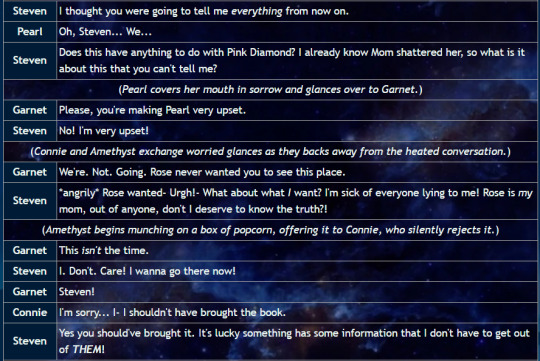
Steven thought he was done with all the Secrets to Supposedly Protect Him back when he found out that Rose ‘shattered’ Pink Diamond. He thought that his family was gonna share stuff with him and be open. So he was extremely mad when he thought that the Gems were keeping yet something ELSE from him (when actually Garnet was trying to avoid the confertation with Blue Diamond she kept future-visoning and Pearl was technically keeping a secret from him... but not necasserly out of her own will). And as he clearly states here, for him, the Gems were LYING to him. When they are not telling him any information, it’s the same as lying to him!
And just as I understand why Greg doesn’t like to talk about his family much, I understand why Steven feels like he’s got a right to know. If it was just Greg not telling a Friend everything about his backstory, it would have been different. But the DeMayos are Steven’s family too, doesn’t he has the right to know about them? Steven has angsted so long about Rose and what’s she like and how unknowable she is to him because he only got to know her through other people’s stories of her... maybe he doesn’t want his grandpa and grandma in this category too. He’s defos has some conflicting feelings about them now. Between being super-charmed by the decor of their house and feeling like he’d be better off raised in such a ‘normal’ situation and between his dad’s super-negative feelings about them.
And remember, “Growing Pains” has just gone over how Steven’s PTSD makes it hard for him to react to Issues in a porpotional manner. Steven has gotten yet ONE MORE THING his loved ones have ‘hidden from him’ or ‘lied about’ (even if it wasn’t Greg’s intentions), and his brain’s Emotional Reference Points are all the OTHER times where his family was keeping Shit hidden from him. Even if Greg’s backstory is technically small peanuts, Steven is processing the shock like he’s realizing the Gems are an Alien Invader race all over again. Like he heard that his mom had murdered someone for the greater good for the first time. Like he is once again seeing Rose Quartz transform into Pink Diamond.
So as far as Steven, processing his Emotions behind the wheel of that car is concered... what Greg did *feels* like what Rose has done. It at least feels equivelent in a way that I don’t think Greg really understands.
499 notes
·
View notes
Text
So I finally made it all the way through Trust episodes 1 and 2 last night and I feel like I had some kind of filmmaking revelation about how deeply who you position as the protagonist influences how we perceive a story. I mean, this is stuff that I knew and I have talked about before, about how who you choose as the protagonist is the most important decision you make when creating a story because you’re telling us where we’re supposed to place our empathy and who we’re supposed to have hopes and fears for and who this narrative belongs to. But it’s striking to find an example that illustrates this so clearly.
Film language has a certain grammar that we’re used to reading whether we’re conscious of it or not, and the order in which we see things has a lot of power to shape what, and who, we perceive to be important. At the beginning of a film story, we’re used to seeing: Here’s a person! Now, here’s their problem. Watch how they try to solve it despite obstacles. That’s what this story will be about.
If you just watched the first episode of Trust and then I asked you to tell me what you thought the show was about, you would probably say it’s about Getty the eldest and his succession problems. The first episode sure sets us up to think that he’s the protagonist, which is a problem, because he’s not just a horrible person I don’t want to spend time with; he’s boring. He’s boring in a narrative sense, because he has no real obstacles in his life. He’s surrounded by people who are at his beck and call; he has all the power in every relationship around him, and so there are no real stakes for him, dramatically.
Lucky for us, he is not actually the protagonist. Little Paul and Primo are. They’re co-protagonists with parallel stories. They are the people whose wants we are following throughout the story. Little Paul wants to get out of this kidnapping alive, and Primo wants the ransom money. And the person standing in the way of both those things happening is Grandpa Getty. Functionally, narratively, he is the antagonist in both of their stories.
(This is why there are so many moments where, despite the fact that Paul is Primo’s prisoner, we see them hoping for the same thing to happen, and it sort of glues them together emotionally--both for us the audience and for the characters themselves--in a really interesting way.)
If you watch episode 3 as if it were the first episode of the series, who the protagonists are is really obvious, because we meet Little Paul and Primo, in sequences that tell us a lot about them, back to back right at the top of the episode.
If you watch the series in order, Little Paul’s character introduction happens when he shows up at his uncle’s memorial service in jeans. He is introduced in relation to Old Paul and Big Paul, as a problem and a disturbance in their worlds.
If you treat episode 3 as if it were the first episode of the series, Little Paul is introduced in his own world, living the kind of life he wants to live and having a blast. Then, we very quickly see his problem (he owes money to dangerous people) and we watch him try to solve it, fail several times, and then come up with the kidnapping idea which launches the main plot of the entire series. If we view it that way, everyone else in his family is introduced in reference to him, which is actually an accurate reflection of the structure of the story.
If we put episode 1 after episode 3, episode 1 suddenly becomes a lot more interesting. Because it’s no longer a story about Old Paul and his rich people family problems, it’s a story about Little Paul trying to get money from this rich asshole, money we already know Little Paul needs to solve a very urgent problem in his life. Suddenly the stakes are very clear and very high, and the whole episode is actually a microcosm of the main plot of the series as a whole. Little Paul needs a comparatively small amount of money to get himself out of a life-threatening problem, and his rich-as-fuck grandfather won’t give it to him.
Switching the POV and storytelling order around also gives episode 1 something it sorely lacks if you watch it as the intro to the series: suspense. Because we already know before Little Paul arrives at Sutton Place that he’s going to fail, and this will put him in the predicament that launches the main plot on its way. But Little Paul himself doesn’t know he’s going to fail, and we the audience don’t know how he’s going to fail, so things like the scenes of Little Paul charming his grandfather in various ways suddenly become interesting, because we’re waiting to see how and when all of this will blow up in Little Paul’s face. Even scenes of Old Paul being horrible to various people become ways of heightening the stakes, because we’re thinking about the fact that Little Paul’s life depends on getting money out of this motherfucker.
Big Paul also suddenly becomes more interesting, because the only thing that elevates him in this story from pathetic self-involved wallowing to a passably interesting tragic figure is the way his emotional self-involvement damages other people, particularly his own son. Now, instead of Little Paul showing up as a problem in Big Paul’s story, it’s the other way around. Viewed this way, Big Paul’s actions in episode 1 become a way of foreshadowing his actions in episode 7, which I think is a really effectively-told tragedy. Episode 7 ends with Big Paul finally doing the thing he’s been wanting to do this whole time, which is stand up to his father. But he manages to do it in the most selfish and destructive way possible, in a way that puts the lives of all of the characters we care about at this point at risk--Little Paul, but also Primo and Leonardo--and launches us into the tension of the pivotal episode 8.
Switching the episode order also makes a whole bunch of tiny details in episode 1 pop. We know Little Paul is lying when Old Paul asks him if he does drugs, so we’re waiting for that lie to blow up. The crucial detail of the Playmen magazine shoot is also highlighted, because we’ve already seen this photoshoot in the opening montage of episode 3 and we recognize the damning cocaine t-shirt instantly.
In addition to being an exercise in how directing the audience’s POV controls our emotional experience of a piece of media, this is also a really good example of how telling a story non-chronologically, in a way where the audience already knows how a plot point resolves, doesn’t kill the tension but can often heighten it. And in general this is something that Trust is very effective at--perhaps most masterfully so in episode 5, where we spend the entire episode knowing that Little Paul and Angelo are not going to successfully escape but still get extremely invested in them trying.
As for why the creators set the series up in a way that foregrounds the least interesting characters and buries the natural starting point of the story in episode 3...I don’t know. Desire (or pressure from the network) to frontload the actors who were best known in the US? Confusion about how (un)interesting these rich people actually are, and why? Who knows. But I think this contributed a lot to the mostly lukewarm critical reception when the show first came out (especially knowing that most reviews were only based on the first three episodes, which is what critics were allowed to see in advance of the premiere.)
In conclusion, now you have the correct viewing order for Trust; thanks to Luca Marinelli for being compelling enough to make me skip to episode 3 and get invested in this show; and if I ever teach a filmmaking class I am definitely using this as an example when teaching a lesson on suspense, POV, and choosing the most interesting protagonist.
#trust fx#primo nizzuto#long post#storytelling#script analysis#filmmaking#story structure#trust alternate watch order
82 notes
·
View notes
Text
First time read through light novel vol. 7. Random thoughts.
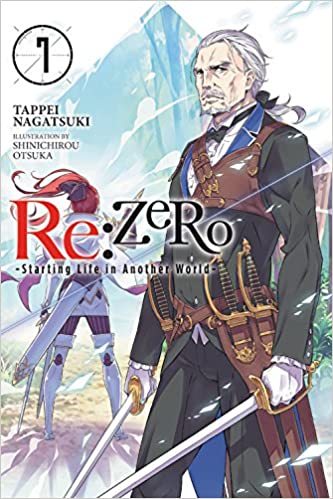
Through some kind of mistake, Rem had completely accepted Subaru, but he knew all too well that the Subaru Natsuki she saw was an ideal far removed from the real thing. Compared with the man she envisioned in her mind, the cards that the real Subaru held were few in number, and poor in quality—
But he learned, now that he stood at the playing table, no one cared about his personal problems.
All anyone in his position could do was try to win with the cards he was dealt.
This is sign I think Subaru has grown a little bit, though he is still growing. It's not about him, and Ferris later seems like he's trying to drill that into him a bit more later when Subaru wants to help with the battle preparations. It's good that he wants to help but sometimes he's unintentionally making things too much about himself, just to ease his own feelings. There are places where he would be getting in the way if he tried to help and Subaru's learning to accept that; to be patient and give his services where he can actually be of use, not just to help himself feel better. And damn, does he put that new maturity to good use in the big battle.
Originally, these negotiations had been Rem’s appointed duty. He could easily imagine how being unable to divulge her task to Subaru and having to speak with Crusch day after day had whittled away at her spirit.
Subaru had continually rotted by himself while the future of the Emilia camp had been entrusted to her—she must have suffered under that burden.
He hoped that in some small way, this victory repaid the girl whose feelings had supported him for so long; if so, then for the moment, that was enough for Subaru to be happy.
I really like this part. Again, it's not all about Subaru. He's acknowledging how much Rem's had to deal with while he was having his breakdowns and indulgences during his prior loops, and how much she still did what she could to support him in spite of it all. We're getting a little more that she does have a life outside of just Subaru and a little more added on to why he feels he's been so selfish. It really feels like he is now doing this for her. It's not like Subaru was completely self-centered before but I imagine there were times, especially with Emilia, where he wanted to help, but he wanted to be the one to help. He wanted good things for her but part of him cared more that he was the one giving them to her, verses her just getting what she needs in general. It's like how he couldn't feel happy that Otto was in support of Emilia first time he met him, though of course that was when he was at one of his lowest points.
And, of course, I'm absolutely reveling in all the sweetness of Rem supporting Subaru through his negotiations. Even if it's just holding his hand and reminding him she's there, he clearly appreciates the strength and courage it's giving him. Obviously they're not a romantic couple but this is the kind of stuff I love to see in romantic relationships. Just the basic comfort and support they find in each other's presence.
“...If I am gone, will you remember me just as long?”
“...I don’t wanna answer that. It’s bad luck.”
Speaking with a voice of dismay, Subaru gave Rem’s forehead a little poke.
When he touched Rem’s forehead, she smiled with a happy expression, almost as if she’d received the reply she had been hoping for.
Given something I believe I've been spoiled on for what happens later in the story (after where the anime leaves off), this feels like a very cruel monkey's paw bit of foreshadowing.
“Subaru.”
“...What?”
“I am fine with being your second wife.”
They were words to make a man unwittingly halt in his tracks.
When Subaru, unable to resist, looked toward her, Rem made a face like that of an adorable puppy, seemingly wagging her tail as she awaited Subaru’s reply.
Oh, good grief, just how far is this girl gonna—?
“If Emilia-tan’s a very generous first wife...”
“Well then, when we get back you must convince Lady Emilia. I shall try hard as well.”
Rem clenched the hand not grasped into a fist, very animated as she spoke with a smile.
Speaking jokingly like that broke all the tension, driving home to Subaru how weak he was. He truly couldn’t hold a candle to the girl.
I'm...going to have to see where the story goes from here, and how truly joking/serious Rem was with that second wife line. Just to put it out there, I don't really have a good view of polygamy. I'm always going to think that, 1st wife or 2nd or 3rd or wherever, someone is always going to be treated like second best and second priority. What they're receiving doesn't feel like real love and that's not fair to them. The only way I can see myself supporting a polygamous marriage in this series is if it's made clear Emilia and Rem are attracted to each other as well as Subaru and want to bang. Then it at least becomes three people who love each other as opposed to just "the guy and his two prizes".
So, first time you read this part in the novels or watched it in the anime, was anyone else afraid of the White Whale not showing up where and when Subaru told everyone it would? Like the world would just want to gut punch him one more time and have everyone think he's a fraud? I remember I was.
One theory I have for why the witch's scent grows stronger, not just when Subaru RBD, but also when he tries to talk about RBD is that maybe the witch likes when he acknowledges her "gift" to him. But she's also quite screwed up and doesn't like it when he tries to "share" what's between them, thus why she punishes him or those around him for doing so.
In front, behind and up above, he saw yet another whale-shaped figure high in the sky, scattering mist all around.
—The infinite mouths of the three White Whales laughed together, drawing out the despair of men.
Subaru, Crusch, the soldiers, everyone, etc.
Though pests had interrupted it, the White Whale’s mission was to cover the world in mist. This, too, was the command of its instinct, and doing so was the purpose of the White Whale’s existence.
One thing I've enjoyed about the various light novel series I've been reading is that, compared to their anime, I get a better idea of various characters' and monsters' mentalities. The best example I could give would be the goblins in Goblin Slayer (that they are not mindless creatures; that they know EXACTLY what they're doing to people and they enjoy it) and this bit with the White Whale is another good one. It seeks to cover the world in its mist and thus destroy/consume/erase everything (maybe?) And it doesn't know why it seeks to do this. It just does, suggesting there is something else, possibly the one behind its creation, driving it.
It's also interesting that, to the White Whale, the witch's scent is described as foul, despite the stories that she's the one who created it. This brings to mind a couple different theories.
Satella didn't actually create the whale. Someone else, perhaps one of the other six witches did or one of the archbishops.
Satella did create the whale but maybe used one of the other witches to do it. Puck did mention something about Gluttony when he sensed the whale approaching in the last loop.
Satella REALLY cannot tell the difference between positive and negative emotions, even more so than we were already led to believe.
Kind of cruel of Rem to trick Subaru into thinking she was dying, but at least we do get Subaru's completely true feelings out in the open. Back to the polygamy matter, I don't have a problem with Subaru being indecisive between Emilia and Rem or being in love with them both. It's not just that they've done so much for him, in which case the relationship would feel just like how Emilia described, just the two of them repaying debts to each other. Both women have been a hugely positive influence on Subaru's life. They've impacted it for the better and helped push him into being more of a man he can live with being, and it works the other way around too. It would be hard to imagine his story without either of them in it. I feel the same way with Code Geass in regards to CC, Shirley, and Kallen in Lelouch's story. It was the only "harem" series I've ever watched where I had trouble saying who the MC should end up with, because all three were irreplaceable in his life and story. Take any of them out and it loses a lot. Emilia and Rem are a similar case.
As Rem looked back at Subaru, now beside her, large tears filled her blue eyes. It was not being left behind that she feared. No, what she feared more than anything was—
“When you are in distress, Subaru, I want to be the one offering my hand faster than anyone. When you hesitate along your path, I want to be the one pushing on your back. When you challenge something, I want to be at your side, stopping you from shaking. That is—that is all I wish for. So please...”
Again, more great parallels between Subaru and Rem, as this isn't dissimilar to what he wanted to do for Emilia.
Wilhelm might just be the biggest example of a tsundere I've ever seen. Married a woman he loved from the bottom of heart for what was assumedly a decent amount of time...never freaking told her "I love you" until he finally killed the beast that killed her.
As for Theresia, it's definitely a case of why context is so important. She never wanted to be the Sword Saint. She only did so because she found purpose in saving as many lives as she could with the insane power she had (the whole "great power, great responsibility" chestnut). If Wilhelm is strong enough to protect and save people, to where her absence would make no difference, then she doesn't have to be the Sword Saint anymore and can live the life she wants. It's what makes it an actual kindness vs. some chauvinistic BS. Probably helps too that she'd already helped put an end to a long war, so she wouldn't have been needed as much anyway.
“So it is said. The existence and origins of demon beasts are mysteries to us. Some propagate in the same manner as ordinary living creatures, but some suddenly appear out of nowhere like the White Whale. Though, properly speaking, the only exceptions on par with the White Whale are the Black Serpent and the Great Hare.”
Oh...I'm so not looking forward to meeting those two. After how much tragedy just the White Whale caused, what the f**k are those things going to do? My money would be that whatever it is, it will hurt Subaru quite horribly.
This book potentially answered a question I had in my last post. The Witch Cult is after Emilia because they see her as an impostor of the Witch of Envy, or at least so the characters in-story are speculating.
Not sure how many people here are fans of Rising of the Shield Hero but after this I kind of want to see the White Whale and the Spirit Tortoise duke it out. That sounds awesome. Mountain Turtle vs. Witch Fish.
Original Reddit post: https://www.reddit.com/r/Re_Zero/comments/gub735/novels_first_time_read_through_light_novel_vol_7/
2 notes
·
View notes
Text
The Elephant in the Room
In my previous essays, I have covered how the Kingdom Hearts narrative follows Maureen Murdock’s template of the Heroine’s Journey, as well as how various characters and story elements tie in with the overarching themes of the framework. Before I can continue to dig further into other themes and archetypes, there is something I need to address first. While I have avoided directly touching on the topic in my previous essays, I have now reached the point where it is no longer possible to talk about the Heroine’s Journey in full without acknowledging the elephant in the room:
Romance.
In ongoing serialized stories such as TV shows and video games, conversations about potential relationships in canon are often treated as inconsequential to the overall story. Something that is separate from the main plot. At worst, I have seen fans who openly center a ship in their analysis and theories be dismissed and criticized as biased - or worse, delusional. They are treated as being so obsessed with their pairing that they try to make everything about their ship and jump on any excuse to declare that it’s viable in canon.
Among the Kingdom Hearts fandom in particular, this has often taken the form of someone trying to dismiss other fans’ hope for a ship to be canon by saying that the series is about friendship, not romance.
While friendship is absolutely an important theme in the Kingdom Hearts series, to insist that this is mutually exclusive from depicting the development of romantic relationships ignores the continued presence of canon Disney romances in almost every game in the series. In each “main” game where Sora is playable, he has directly or indirectly been involved in getting those Disney couples together in the KH universe. So it’s not out of the realm of possibility for the series to turn the tables and give some attention to his romantic interests for a change.
A story having other major themes is not mutually exclusive from showcasing the development of a romantic relationship. There are many popular movies, shows, books, comics, and video games in which a romantic relationship plays a central role in the narrative but there are still other plotlines going on that are equally as important as the romance. This is especially true for Disney and Square Enix.
The reason why it’s impossible to fully talk about the Heroine’s Journey without acknowledging romance elements is best encapsulated by this quote from She-Ra showrunner Noelle Stevenson about her show’s endgame pairing in an i09 interview after the release of the final season:
“The show’s not a romance show. It is about a lot of things. It’s about choice, destiny, fighting, tyrants, you know, all of these other things. I grew up with so many stories—like sci-fi and fantasy—that I was so passionate about. And it would be considered no big deal to have the hero get the girl and to have a kiss at the end, without it suddenly becoming a romance or ‘Oh, the shippers got what they wanted.’ It was just a part of the story. And to actually see it be a central part of the plot and to fulfill the arcs of the characters in a way that felt satisfying. I really want to take it beyond ‘Oh, the shippers got what they want.’ Like, it’s not just a ship for me. It is a plot point. It is the necessary conclusion of each character’s arc, separate and together.[1]”
While not every story known to follow the Heroine's Journey features a romance for the main protagonist, those that do make the romance an integral part of the narrative. It’s not something thrown in at the end to please shippers, but a central component of the story. Therefore, when analyzing a Heroine’s Journey story, it is vital to acknowledge and discuss textual support for potential romantic relationships in order to have a full understanding of the narrative.
Even if one is not aware of the Heroine’s Journey, Sora’s repeated interactions with Disney romances indicate that there is a high probability that he will be in a romantic relationship himself by the end of the series. Every story I know of that follows the Heroine’s Journey broadly adheres to a pattern in regards to how the romantic relationships of a main character are set up.
By examining the series through these patterns, we can narrow down who Sora’s endgame romantic partner will be.
Because the themes and character dynamics emphasize resolving internal conflict through balance, the Heroine’s Journey lends itself extremely well to Beauty-and-the-Beast, rivals-to-lovers, and enemies-to-lovers relationship dynamics. A major component of the Heroine’s Journey is the main character learning to accept themselves, and since the Animus as a Shadow figure can represent the parts of themselves that they haven’t accepted yet, it is simpler to symbolize that self-acceptance via a romance with the Animus rather than attempting to build a separate relationship on top of the existing story framework.
For these reasons, the Animus is more often than not the main character’s endgame love interest, their feelings for each other made into critical aspects of their respective character arcs. The only Heroine’s Journey stories with romance that I know of where this wasn’t the case are ones where executive meddling resulted in the finale being rewritten to kill off the Animus despite established narrative set up for them to have a happy ending together[2], while the protagonist was either forced into a relationship with a different character or left single.
And like I said in previous essays, the one character in the series who fulfills all criteria for the Animus role within this storytelling framework….
Is Riku.
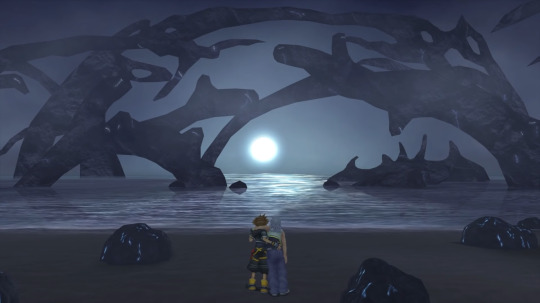
[Image Description: Sora supporting Riku as they walk toward the ocean on the Dark Margin at the end of Kingdom Hearts II. End Description.]
As mentioned in my earlier analysis, this narrative framework emphasizes the importance of balancing contrasting attributes, which fits in extremely well with Kingdom Hearts’ focus on balance between light and darkness. For stories that follow the Heroine’s Journey in a visual medium, that dichotomy is often incorporated into the characters’ look. Height differences are common, while their color schemes and outfits are designed to make them complement each other. Further adding to the focus on balance between light and darkness, the visuals of the story frame the romantic leads with imagery associating each one with light or darkness to create Yin-Yang symbolism when they are finally in balance.
In Re: Chain of Memories, Vexen openly calls Riku the “Hero of Darkness[3]” as a counterpart to Sora’s role as the “Hero of Light”, and their combination attack in Kingdom Hearts II utilizes moves that reflect both elements. In the Ultimania for the original game, Tetsuya Nomura said that Riku’s look was intentionally designed to balance Sora’s[4], and the contrast between their respective color schemes is maintained in each of their new outfits. In Kingdom Hearts II and Dream Drop Distance, Riku wears white and blue, while Sora in those same games wears black and red. Two different pairs of contrasting colors. Kingdom Hearts III has them both in outfits that are primarily black and grey, but still emphasize the blue and red that have been part of their respective outfits since the first game.
In a Heroine’s Journey, the love interest is typically an active character in the story and usually serves as the deuteragonist. This fits with Riku having been a mandatory playable character in multiple games since 2004. In addition, series producer Shinji Hashimoto said before the release of the HD 1.5 Remix collection[5] that the main focus of the series is how Sora and Riku develop both as individuals and as a pair, which fits with how the central conflict of the Heroine’s Journey revolves around the dynamic between the Protagonist and their Animus.
A common viewpoint held by many fans of the series is that Kairi is Sora’s love interest, and it’s not hard to see why people get that impression. He has sacrificed himself to save her in two separate games now. He’s charged enemies head on in order to rescue her whenever she’s been captured. He even got down on his knees and begged for her freedom when Saix demanded he show how important she was to him. Multiple characters have talked about how special she is to him, and Roxas refers to her as “that girl he(Sora) likes.”
However, there are multiple elements in the narrative that point to them not being the endgame romance. Kingdom Hearts III foreshadows the final shot of them sitting on the paopu together at the end of the game with Sora disappearing from the cover of the 100 Acre Wood storybook, textually framing Winnie the Pooh as a parallel to Kairi. While many fans regarded their sharing paopu fruits in the base game as the beginning of a relationship between them, he still only refers to her as a friend in Re:Mind, and even compares his bond with her to the bond between Ventus and Chirithy.
Sora also does not treat his promises to her with the seriousness he would if they were going to end up together. The promises to return her lucky charm and to come back to her that he makes in the first game are never treated as anything urgent when he awakens in Kingdom Hearts II. Instead, he declines the opportunity to return to the islands and check in with her in favor of searching for Riku. When Kairi says in The World That Never Was that they’ll be together every day, Sora agrees, yet he was content to spend the rest of his life on the dark beach at the end of the game as long as he was with Riku.
Meanwhile, the most consistent theme regarding Kairi in relation to the Destiny Islands trio is the idea of childhood friends drifting apart as they get older[6][7]. This is particularly highlighted in Kingdom Hearts III, with Kairi writing letters to Sora that she never sends, thereby keeping her thoughts to herself. Merlin also emphasizes this when he talks about forging new connections after Sora’s visit to 100 Acre Wood. This parallel frames the ending of Re:Mind as the two of them recognizing they’ve drifted apart and choosing to put in the effort to renew their friendship by spending time together.
On a structural level, her portrayal does not fit with how love interests are typically depicted in the Heroine’s Journey, both as an individual and in relation to the main protagonist. There is no contrast between her and Sora’s designs or roles the way there is between his and Riku’s. Her color scheme is predominantly pink, which does not have the same contrast with Sora’s red as Riku’s blue. Because she’s a Princess of Heart, there is no dark and light contrast, and the combination attack she shares with Sora in Re:Mind only utilizes light-based moves. It took 17 years after her first appearance in the series for her to be made a playable character, and even then, playing as her is not mandatory. They are never portrayed as equals, and she is not an active force in his emotional growth.
The Heroine’s Journey was crafted for narratives revolving around identities that have been Othered by society for one reason or another. Murdock designed her template as a tool to help women deal with being shamed by society for expressing and pursuing their desires. In a similar way, LGBTQ+ people also face stigma from society for expressing and pursuing their desires. So it makes perfect sense that a framework for narratives of people overcoming internalized stigma against important parts of themselves would be ripe for stories featuring LGBTQ+ protagonists of any gender.
As mentioned in previous essays, stories that follow the Heroine’s Journey challenge the biases and blind spots of the audience. A relationship between Kairi and Sora does not challenge anything because she has largely been regarded as the endgame love interest by default since the beginning. Meanwhile, a romantic relationship between Sora and Riku challenges players to recognize heteronormativity within themselves and in the media around them. It challenges people to examine the lens through which they perceive the story and rethink how they look at what’s happening in the narrative.
In summary, the portrayal of Kairi and her bond with Sora is not consistent with how love interests are commonly depicted in the Heroine’s Journey, while the portrayal of Riku and his bond with Sora is. If Sora’s story is going to continue on this storytelling formula to the end, the structure of the Heroine’s Journey narrative leaves Riku as the only thematically viable candidate for the role of endgame love interest.
Now, as some people bring up in conversations about Soriku, there is a potential obstacle in the form of corporate executives. It is entirely possible that Disney will drag their heels and try to force the development team to downplay or remove any open same-sex relationship the series may try to depict. They do not have a strong track record of LGBTQ+ representation that isn’t a minor character who only appears for one scene. Given that their last IP to follow the Heroine’s Journey - the Star Wars sequel trilogy - crashed and burned at the end, executive meddling is my greatest fear for this franchise.
But the thing to keep in mind is that Tetsuya Nomura is stubborn as hell. One of the reasons the long gap between Kingdom Hearts II and Kingdom Hearts III was because he was holding out for permission to include Pixar movies in the game, outright refusing to start work on KH3 until they were given that go ahead[8]. If you want further proof of how stubborn he can be, this is how he described the meeting where he first pitched the series to Disney in a 2012 interview with the late president of Nintendo[9]:
Iwata: Their ideas were different from yours, naturally…
Nomura: Yes. They appeared to believe that we would make whatever they wanted us to make and came up with rather specific requests such as, "We'd like the game to feature this character." They were really excited, explaining their ideas... To be honest, though, I wasn't really interested in any of them. (laughs)
Both: (laughter)
Iwata: You wanted to borrow Disney's characters in order to make a new game that could compete with Mario 64, and you already had a vision of what this game would look like. I suppose their ideas didn't fit in with this vision.
Nomura: They didn't, no. In the end, I actually stopped a presentation halfway through. We didn't have that much time, and it looked like it was all going to get taken up by various Disney presentations. So, I interrupted them and told them the conclusion by saying, "I won't make such games."
Talk about nerves of steel. This man basically said “we do this my way, or we don’t do it at all” TO MOTHERFORKING DISNEY, AND. HE. WON. If there is any human being with enough force of will to make the Mouse House cave in and allow the depiction of an openly LGBTQ+ relationship in the Kingdom Hearts series, it is Tetsuya Nomura.
I cannot say with 100% certainty how things will go. But everything I know about storytelling patterns and narrative structure is telling me that Kingdom Hearts is a textbook Heroine’s Journey with a romance between Sora and Riku at its core. A relationship between the protagonist and the Animus does not truly begin until the “Integration” stage at the end of the Journey, and we are rapidly approaching the point in the narrative where the two leads traditionally become aware of and acknowledge their feelings in order to be on the same page for the finale.
Sources:
[1] “She-Ra's Noelle Stevenson Tells Us How Difficult It Was to Bring Adora and Catra Home” May 18, 2020
https://io9.gizmodo.com/she-ras-noelle-stevenson-tells-us-how-difficult-it-was-1843419358
[2] “Death of a Dark Youth, Desecration of the Animus”; December 20, 2018. https://www.teampurplelion.com/death-of-a-dark-youth/
[3] Kingdom Hearts Re: Chain of Memories. Square Enix, 2007.
[4] “A Look Back: Kingdom Hearts Ultimania Gallery Comments Part 1″; August 30, 2019;
https://www.khinsider.com/news/A-Look-Back-KINGDOM-HEARTS-Ultimania-Gallery-Comments-Part-1-15519
[5] “How Kingdom Hearts III Will Grow Up With Its Players;” September 24, 2013.
https://www.ign.com/articles/2013/09/25/how-kingdom-hearts-iii-will-grow-up-with-its-players.
[6] “E3 2018: Tetsuya Nomura on If Kingdom Hearts 3 Is the End of Sora's Story”; June 14, 2018.
https://www.ign.com/articles/2018/06/14/e3-2018-tetsuya-nomura-on-if-kingdom-hearts-3-is-the-end-of-soras-story
[7] “Character’s Report Vol. 1 Translations”; Jul 16, 2014
https://www.khinsider.com/forums/index.php?threads/characters-report-vol-1-translations.195560/
[8] “Edge Magazine Features Kingdom Hearts III Cover Story”; January 9, 2019. https://www.khinsider.com/news/Edge-Magazine-Features-Kingdom-Hearts-III-Cover-Story-14331
[9] “Iwata Asks: Nintendo 3DS: Third Party Game Developers, Volume 12: Kingdom Hearts 3D [Dream Drop Distance], Part 2: It’ll definitely be fun”; April 2012.
https://iwataasks.nintendo.com/interviews/#/3ds/creators/11/1
#kingdom hearts meta#kingdom hearts theory#kh speculation#kingdom hearts analysis#kingdom hearts and the heroine's journey#soriku
74 notes
·
View notes
Text
The Silmarillion as a TV/Netflix Show (Part 5)
Season 5 centres on Túrin, Tuor, and Dior - and, later, Elwing and Eärendil. The last two seasons have looked hopeful for a while but ended on tragic notes (the Bragollach and the Nirnaeth); this season is going to flip things by being almost unremittingly tragic but ending on a hopeful note.
There are a few key things to do here:
1) Draw out parallels and common threads between our main characters. At first I wanted to shift the timeline a little and have key events in Túrin and Tuor’s lives happening at the same time: Túrin as outlaw, Tuor as thrall and then outlaw; Túrin in Nargothrond, Tuor in Gondolin; Túrin and Finduilas, Tuor and Idril. But it felt like there were too many big events happening simultaneously, and it was hard to fit them all in. Still, the parallels between the cousins are present.
Dior needs more characterization in order to be able to hold his own, narratively speaking; we have very little on him in canon.
2) The Fëanorians will be very important in the last few episodes of the season, so they need to be worked into the storyline of at least some of the earlier episodes to keep them in view. I’m going to go with them being based on Amon Ereb for this period; it fits some of Tolkien’s versions, and having them in Ossiriand at the same time as Beren and Lúthien and Dior would feel like a massive Chekhov’s Gun that is never fired.
So, with that in mind:
Episode 1: Túrin is going to take centre stage here, with the episode covering everything from his departure from Hithlum up to the death of Saeros and Túrin’s departure from Doriath. (And the episode will start with the Words of Húrin and Morgoth.) There will also be a few scenes from Tuor’s and Dior’s childhoods, which were comparatively more stable. Since Beren and Lúthien had such a large part in the last season it will be nice to see their experiences of parenthood. Lúthien, never having met mortal children, will be shocked at how fast Dior grows up. (He definitely ages on a Mannish scale - he’s married at 22, a king at 27, and dead at 30.)
Near the beginning, the episode will also include a scene where the Fëanorians attempt to invade Doriath and are turned back by the Girdle of Melian. It doesn’t function as a direct, physical barrier; it causes confusion and disorientation and strange visions and a loss of sense of direction, and you look around and find you’ve ended up outside Doriath again. This eerie, hallucinatory quality fits Melian’s background as a Maia of Lórien, Master of Dreams. (And hey, if you can work some subtle prophetic/ominous foreshadowing into the visions, all the better!) The purpose of the scene is to show that the Fëanorian’s aren’t idle; they do want pursue the Silmaril, but for the moment it is beyond their reach. The brothers will have varying levels of enthusiasm about the plan, with Celegorm and Curufin being the ringleaders.
Episode 2: Heavily focuses on Túrin’s time as an outlaw, from his first meeting with the bandits through to Dor-Cúarthol, the fall of Amon Rudh, and the death of Beleg. This is a lot of material - joining the bandits, becoming their leader, the first meeting with Beleg, finding Mîm and Amon Rudh, Dór-Cuarthol, and the fall of Amon Rudh and the death of Beleg. There may be a need to streamline it, with Beleg only finding the outlaws once they are at Amon Rudh, and staying with them then.
There’s a lot of good characters here, and a lot of good personality confllicts - it’s practically a short movie in itself. Particular care needs to be taken with Mîm, who cannot be allowed to become a caricature.
This episode introduces Anglachel, so it would be good to have a short Gondolin scene with Maeglin (bearer of Anguirel) to establish the symmetry. And also to keep Gondolin in the viewers’ minds. A short scene in Nargothrond showing their reaction to Dór-Cúarthol (positive: it is or was their realm, and he’s doing more to defend it that they are) will set up later events,
Episode 3: The focus splits between Túrin in Nargothrond - particularly his relationships with Gwindor and Finduilas, and his growing prominence, with him becoming de-facto in charge at the end of the episode - and Tuor as a thrall and later outlaw. Tuor’s personality really comes to the fore here: he’s patient, and steady, and kind. He puts up with considerable abuse an a thrall, escapes when there’s an opportune moment, and can’t be effectively pursued because he’s made friends with all of his captor’s hounds. (I especially like that last fact.) The episode ends with him leaving Dor-lómin by the Gate of the Noldor.
This is also a good time to build up the romance between Dior and Nimloth. Nimloth must be Laiquendi, as those are the only other people Beren and Lúthien would meet in Ossiriand; I rather like the idea of them being childhood friends, to offset some of the more love-at-first-sight romances. Dior is now in his late teens and - this is important - very, very good-looking, even by elf standards. He’s also very interested in his Doriathrin heritage, and asking his parents a lot of questions about his grandparents; that sets up his determination to be Eluchíl later on.
Episode 4: Tuor’s meeting with Ulmo and his coming to Gondolin, the Fall of Nargothond, and Túrin in Dórlomin. The fall of Nargothrond and deaths of Gwindor and Finduilas form a nice counterpoint/contrast with Tuor’s meetings with Voronwë and Idril and his arrival at Gondolin. Túrin’s impulsive actions in Dor-lómin contrast with Tuor’s approach in the prior episode as well.
Episode 5: Focus is on Túrin’s story. Journey of Morwen and Nienor to Nargothrond and its consequences, and Túrin in Brethil, through to his slaying of Glaurung and his and Nienor’s deaths.
For extra bonus irony points, parallel the wedding of Túrin and Níniel with the weddings of Idril and Tuor and of Dior and Nimloth.
Episode 6: Wanderings of Húrin through to the Sack of Doriath and Beren and Dior’s fight with the dwarf-army. (Dior isn’t mentioned as being part of this fight in the Silm, but it’s an excellent moment to include him here.) The Fëanorians reenter the scene, attempting to intercept the dwarf army carrying the Silmaril, but arriving too late. This is the best chance they’ve had st recovering a Silmaril yet - they’re not going to ignore it.
The line “while Lúthien held the Silmaril no elf would dare assail her” is typically read as it just being something no one would consider on a moral level - and that’s a valid reading - but I like the idea that the Fëanorians aren’t going after her because they’re freaking terrified of her. This is the woman who defeated Morgoth single-handedly! Holding one of the most powerful artifacts ever created! Who knows what she could do! (The Fëanorians absolutely make concessions to practicality when it comes to the Oath - otherwise they would have attacked Angband sometime in the 400 years of the Siege, or after the Nirnaeth as a way to die pursuing their oath in a decent way rather than slaughtering kin. It’s only the final attack by Maedhros and Maglor after the War of Wrath that they attempt in the face of impossibility, and by that time I think suicide-by-Valarin-army makes up a solid portion of their motivation.)
Episode 7: The refounding of Doriath, the Second Kinslaying, and the capture and treachery of Maeglin. Broad theme of the episode being Bad Elvish Behaviour all round, with elves doing Morgoth’s work either directly (Maeglin) or on their own initiative (the Fëanorians).
My idea on the refounding of Doriath, and on Dior’s title of Eluchíl (Thingol’s Heir) is that this quickly and breifly becomes the core of Elvendom in Beleriand. Dior, as Lúthuen’s son and Melian’s grandson, likely has some degree of ‘magical’ power beyond what is usual for elves. Not enough to reestablish the Girdle of Melian, but enough to provide some general deterrance against evil forces. Doriath is also, for the first time, open to all the other free peoples of Beleriand, and is the only true realm remaining aside from secret and mysterious Gondolin. Not only do the Doriathrin Sindar and some of the Laiquendi and the northern grey-elves unite around Doriath, various Noldor, remants of lost realms and destroyed armies, join them. Dior is becoming in truth what Thingol claimed to be: King of Beleriand. All the more so when the Silmaril comes to him and Doriath blossoms like a memory of Valinor in the Ages of the Trees.
And this would fit with why the Fëanorians would regard Dior as ‘proud’, this would offend them more than anything, because what he’s achieving is exactly Fëanor once boasted that he would achieve, long ago in Tirion. This would fit with the sheer visciousness of the Second Kinslaying, with the abandonment of Dior’s young sons in the forest. Celegorm’s people aren’t even thinking in terms of hostages; they just want to destroy Dior’s entire family line, because his existence, his kingship, what he’s achieved are such an affront.
But Elwing escapes, and the Silmaril is still out of their hands.
(The attack is at Yule, whuch sets up a strong and deliberate parallel - Morgoth’s earlier attacks on the Lamps and the Trees were also at times of festival/celebration, so the Fëanorians’ actions are being deliberately equated with his.)
Episode 8: The Fall of Gondolin. This is your absolutely epic big battle scene. Balrogs! Dragons! Eagles! Maeglin acting like a cackling B-movie villain! (I have not read The Fall of Gondolin, but I’ve hear that Idril swordfights Maeglin in it, and this absolutely needs to happen.) Ecthelion kills a Gothmog! Glorfindel kills a balrog! It’s tragic, but it’s also extremely exciting television (unlike the kinslaying the previous week, which was mostly just really depressing and horrific.)
The episode ends with the survivors of Gondolin making their way to Sirion, where the survivors of Doriath have already settled. I think that the survivors of Nargothrond should also be there, to keep things simple and allow for some extra drama.
Episode 9: This one starts with a timeskip, so we can have adult Eärendil and Elwing. The episode is a quieter one, mainky setup for later events: the departure of Tuor and Idril, the marriage of Eärendil and Elwing, the birth of the twins, and Eärendil’s departure to seek the aid of the Valar. The voyage of Eärendil is dramatic and can take up some of the episode.
Episode 10: The Third Kinslaying, the destruction of the Fëanorian base on Amon Ereb, the voyage of Eärendil and Elwing to Valinor, and the Valar’s decision to go to war. The nain reason I wanted the Nargothrondim in Sirion is so that we can get Celebrimbor fighting against the Fëanorian forces here, because that just increases the level of emotional drama. The whole thing’s a traumatic mess. Fëanoruan solidiers throwing down their swords and surrendering. Fëanorian soldiers switching sides to defend the people of Sirion. It’s hard to overstate how teagic this is - here is almost the last remnant of elves in Beleriand, and they are being destroyed not by Morgoth (from whom they would be protected by Ulmo’s waters), but by their own people.
But at the end of the episode, Valinor is marshalling for war, and things are finally. finally, looking like they could get better.
#tolkien#the silmarillion#edain#elves#túrin#tuor#dior eluchil#eärendil#elwing#sons of fëanor#nargothrond#fall of gondolin#idril#maeglin#adaptation
65 notes
·
View notes
Text
Gochiusa BLOOM episode 7 impressions
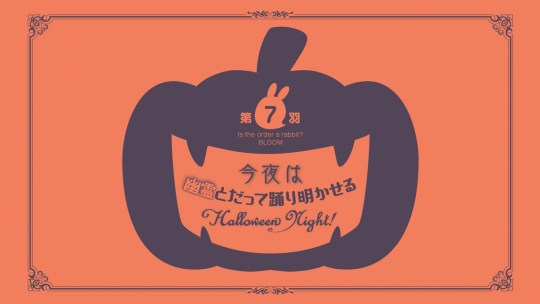
Previously: 6 - 5 - 4 - 3 - 2 - 1
In real world Halloween might have been a month ago, but in the world of Is The Order a Rabbit it’s exactly the season for all things spooky. And maybe things become a little too supernatural for a slice of life show. In the last episode we’ve seen how BLOOM symbolizes the growth of the characters. And as we enter the second half of the season, another meaning is revealed...
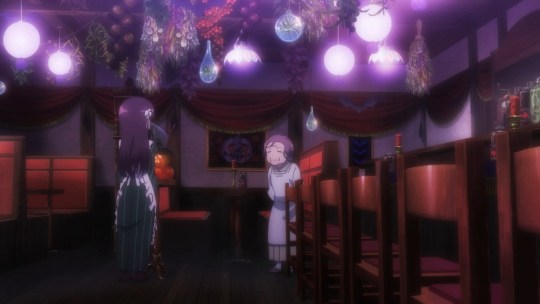
But first let’s visit Ama Usa An, where horror-loving Chiya is decorating the traditional Japanese teahouse for Halloween. Since Halloween is decidedly not a traditional Japanese holiday, it looks kinda surreal, but Chiya’s grandmother is more worried about souls of the dead coming back to life, especially that of Chino’s grandfather (see season 2 episode 9 for more of their backstory). Of course the soul of Chino’s grandfather isn’t actually dead, but is inhabiting the body of a rabbit. It’s not clear how exactly this happened and Cocoa might have been involved.
Speaking of Cocoa, we see her practicing with the magic set she bought in the first episode of the season. She tries to make something appear in her hand, but nothing happens. Clearly you can’t just learn to summon matter into existence in Gochiusa world, or can you? Anyway the shot focuses on a candy laying on a table before the opening sequence cuts in. This must be the object Cocoa has tried to summon and it’s also clearly a foreshadowing for something.
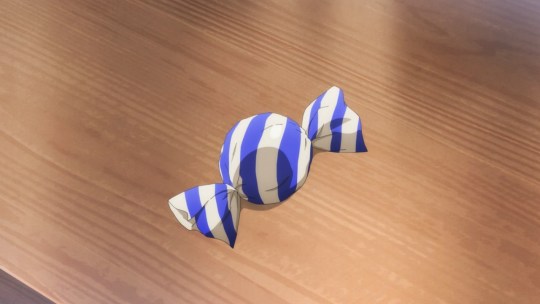
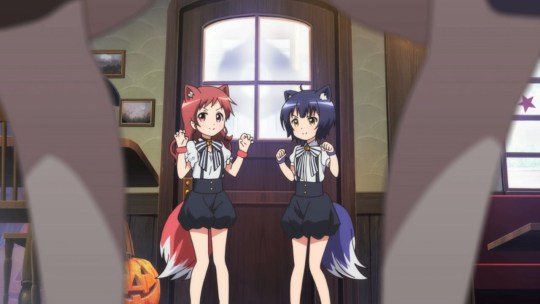
Meanwhile, Maya and Megu are trick-or-treating in matching werewolf(?) outfits hoping to score some free candy. Interestingly the tradition of giving out candy on Halloween has descended from a medieval practice of sharing so-called “soul cakes” which represented the souls of the dead.
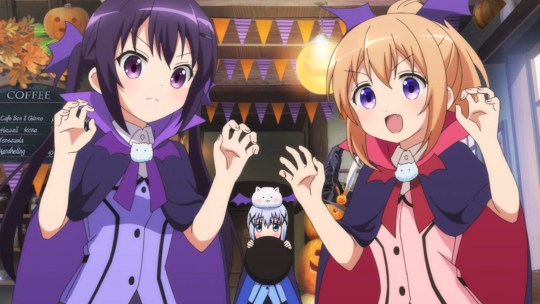
Meanwhile the staff of Rabbit House are dressed as vampires. The theme of vampires fighting werewolves brings up to mind the Twilight series although I’m sure the idea came up many times throughout history. If you look closer, you’ll notice that Cocoa, Rize and Megu have fake fangs (I think Maya’s is natural), although they’re not consistently drawn between scenes, even though in the manga they’re drawn correctly. Maybe they’ll fix this in BD. The only one whose fang is not shown is Chino, and ironically she is the one who actually bites somebody.
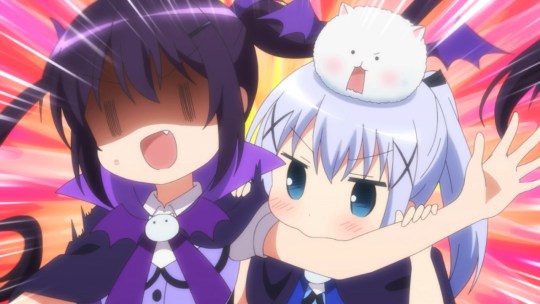
Also the flashback of Chino “roaring” at the mirror reminded me of the scene from Celestial Method where Noel (also voiced by Minase Inori) roars at a dinosaur standee. To be fair it sounds completely different but I just can’t help but compare them.
Also while I was browsing through my copy of volume 6 I found a cute illustration card that seems to be relevant to this episode, but includes Mocha and Cocoa as the wolves and Chino as the vampire (here’s a highres version).
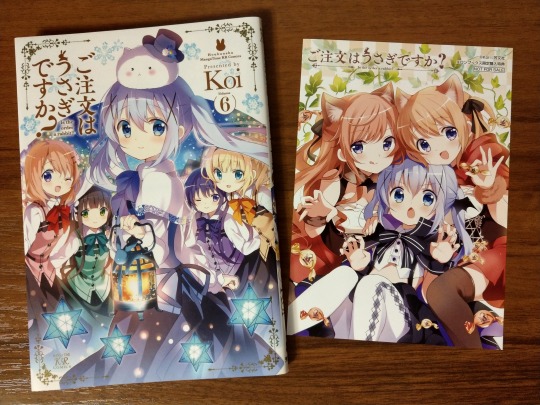
I think I bought this particular volume in Japan on the day it was released. Good times...
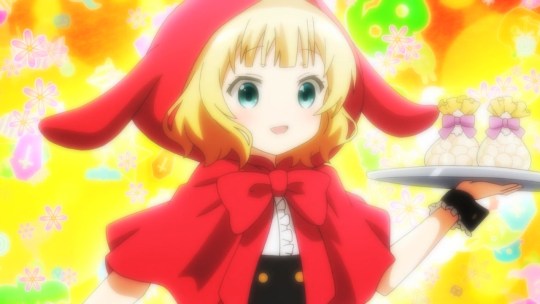
Next MaMe go to Fleur de Lapin and are greeted by Sharo dressed as Little Red Riding Hood (bunny version). This costume appeared earlier in an illustration for the rabbit chapter from the previous episode.
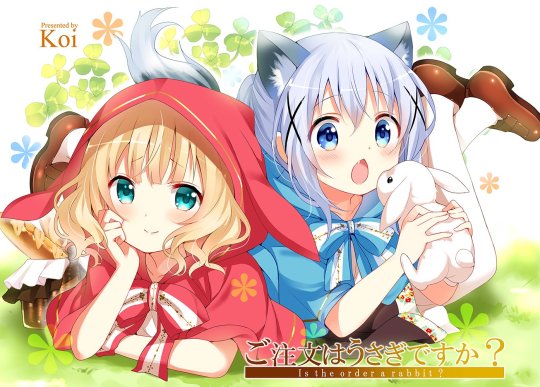
This is also a rare scene where other employees of Fleur de Lapin can be seen, as usually Sharo is shown working there alone. Even in the manga, Sharo is the only employee shown in this scene. In the end it turns out that Sharo is a wolf in disguise and craving for some meat. Which is weird because Sharo hasn’t been shown eating or cooking any meat before.
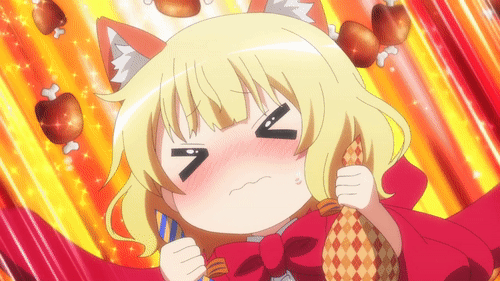
Anyway, next stop is Ama Usa An, which is called the Witch’s Mansion now. Chiya mentions the beginning of the Sabbath, and the manga chapter’s title 今宵は甘兎サバト also mentions the Sabbath. This might be confusing because in Judaism and Christianity the Sabbath is the day of rest and happens weekly (on Saturday or Sunday). However since we’re talking about witches, this actually references the Wiccan concept of sabbat, or one of eight festivals in the Wiccan calendar. In particular, Samhain, one of the four Greater Sabbats pretty much coincides with Halloween and celebrates the beginning of winter.

Chiya does this thing where the protagonist’s hand hurts only to awaken their dark powers, I’m not really sure where this trope comes from but I’ve seen it referenced in anime before and it’s a common chuunibyo stereotype. In this case, Chiya did really just hurt her hand. There’s also some sort of runic circle drawn on her bandages, but if you look closer it says shiratama anmitsu matcha parfait in hiragana.
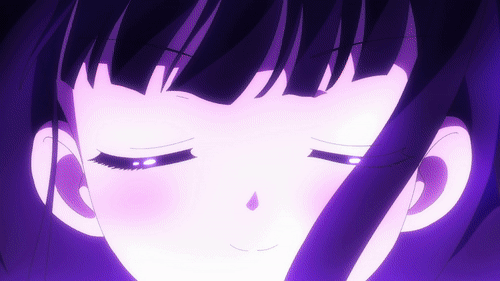
Maya and Megu agree to help Chiya, and become her “familiars”. Even though familiars are better known as a video game mechanic today (which is what the “level up” scene references), witches were associated with familiar spirits since medieval times. A familiar often took form of a small animal, such as a cat. Unfortunately MaMe don’t even know which animal they are, so clearly they didn’t take their backstory as seriously as Chiya did. Their ears and tails look canine to me, so I can see Megu being a fox spirit, but Maya being a cat is less believable. Also during their confrontation Megu confirms that Maya’s fang is her yaeba (snaggle tooth).
As a revenge for the trick MaMe pulled on her, Chiya gives them a selection of pumpkin tarts, one of which is laced with wasabi (which she calls ”Russian roulette”). This seems like a common thing for her, since she did the same with botamochi in season 2 episode 6, and with green tea in season 2 episode 7 (except she used aojiru instead of wasabi). However this time, it was Chiya’s grandmother who put wasabi in two of the tarts, unbeknownst to Chiya. By the way in the manga it wasn’t shown that Chiya got one of the wasabi tarts.
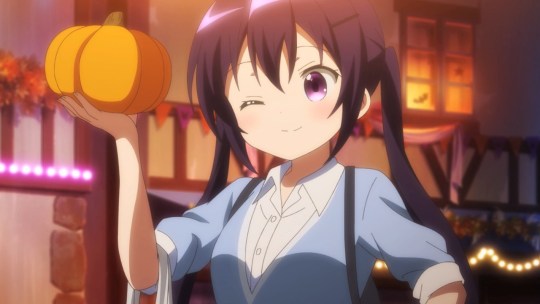
Chiya goes shopping for some pumpkins, but is helped by Rize, and later Sharo gives her anti-pain medications, reminding her of how Chiya tended for her when she was sick in season 1 episode 12. It’s not mentioned in the anime, but Rize also had a “motivation” for helping Chiya, as she hurt her leg before (see season 2 episode 2). Chiya invites Rize and Sharo to dinner and brings up the wasabi-laced pumpkin tarts. According to Chiya the probability of getting wasabi is 1/3. Initially there were 7 tarts, of which 2 had wasabi. Megu, Maya and Chiya eat one each, with Chiya’s having wasabi in it. That leaves 4 tarts with 1 wasabi, so either Chiya’s calculation is incorrect, or somebody ate one more tart.
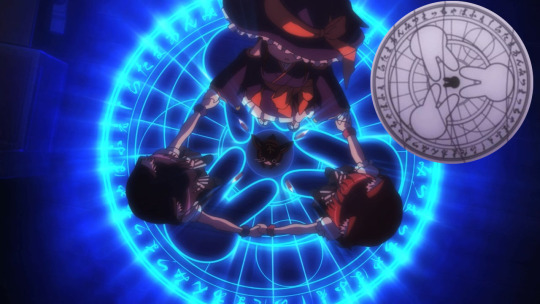
Apparently last day was just a warm up to Halloween (All Hallow’s Eve’s Eve?), so next day Megu and Maya come to Chiya again and try to summon something. A larger and slightly different version of the runic circle previously seen on Chiya’s hand starts glowing and we see that the 3 white rabbits correspond to three people holding hands. There’s also Anko corresponding to the black rabbit in the middle. By the way, in the manga the sign on Chiya’s hand was just a hexagram, and the summoning ritual didn’t have any visible symbols.
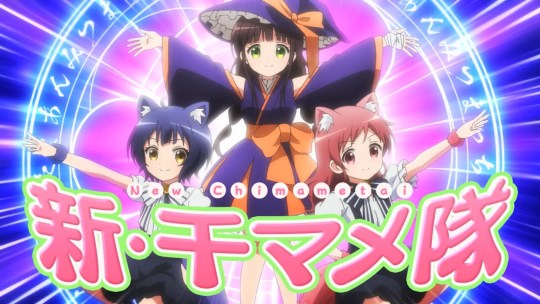
Anyway, they want to summon a messenger from demon world/hell, and coincidentally Cocoa and Chino come in (dressed as vampires) and try to attack (cuddle) them. Chiya, Maya and Megu form New Chimame-tai which works because Chiya and Chino have the same first syllable. However Chi is written with kanji instead of katakana in this version (because Chiya’s name 千夜 is one of the few given names among Gochiusa characters that’s always written with kanji). This defeats Chino, and Chiya consoling Chino like a big sister defeats Cocoa as well.
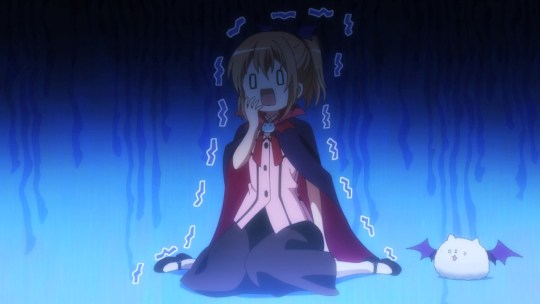
Ok let’s move on to part B, which is the really important part of the episode. The streets of the town are filled with people dressed in various costumes. Cocoa’s classmates can be seen among the crowd, and Aoyama and Rin are enjoying a boat ride on River Sanzu.
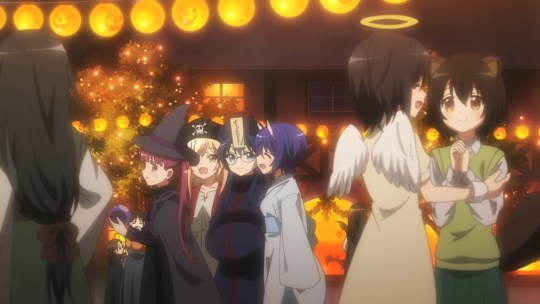
Our main character have also prepared some new costumes for the occasion. First we see Chino, dressing up as Phantom Thief Lapin, while Rize is going as a police officer. Soon Chiya and Sharo join them, who somehow independently of each other also went with a Lapin costume. At least Sharo had a good excuse. For Chiya, Lapin’s gloves obscure the bandage on her hand, so maybe that’s why she chose this costume. But what about Cocoa?
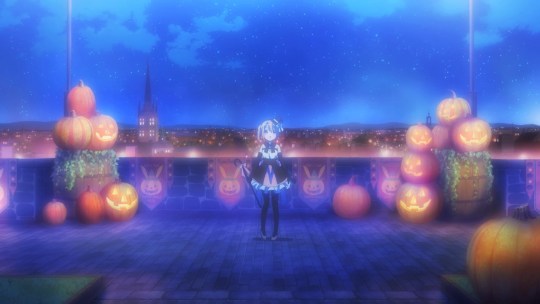
Well, she kinda got lost and we find her at the location that you will recognize if you read my episode 5 review. Cocoa says it looks a little different than usual, almost like a different world (isekai). Well, there’s a lot of evidence to support this hypothesis. First, in a scene that parallels episode 1, Cocoa finds a lost child and tries to calm her down with a magic trick. However you might notice that the child’s head is literally a pumpkin with a moving mouth.

And her mother is also a pumpkinhead. Cocoa doesn’t encounter any other people during this segment, even though you’d think a spot that overlooks the town like this would be quite popular. Well, she does encounter one more person, a mysterious masked magician with an angora rabbit on her head. She also wears a G-clef pendant indicating some sort of music connection.

Now, since y’all had already watched the episode, it wouldn’t be a spoiler to say that this is the ghost of Chino’s mother, Saki. The rabbit on her head is the ghost of the original Tippy before its body was taken over by Chino’s grandfather. The original Tippy was a female rabbit, by the way, a fact established early on in the series. In Sing for You OVA (for which I wrote a not-very-detailed review by the way) it’s established that Saki was a singer and even had a record released.
Anyway, as a ghost, Saki doesn’t speak (although she still can giggle and such) and doesn’t physically interact with Cocoa (only indirectly, by casting candies at Cocoa). Nevertheless she does teach Cocoa how to do the candy trick correctly.
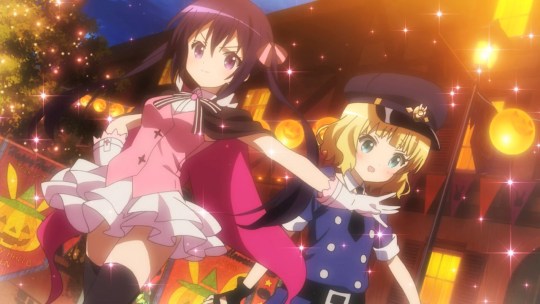
Meanwhile, the rest of the group tries to call Cocoa’s phone but she doesn’t answer. This is another evidence for isekai theory. Cocoa is just out of range, you see. Rize and Sharo swap their costumes (the most unrealistic part of the episode) and Sharo starts “policing” the Lapins on how the real Lapin would talk. Chiya has a bright idea to shout out for Cocoa and call her big sister. However Cocoa would obviously only react if Chino calls her that, so Rize encourages Chino to say it louder (referencing her training for the choir in Sing for You).
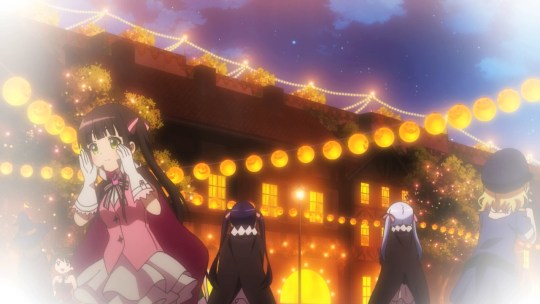
Cocoa and Saki hear Chino, and Saki looks at her daughter from the terrace. Chino also looks up... but doesn’t see anything. She does get a hunch that there’s something up there though, so the group finds Cocoa eventually. Meanwhile Saki feels like her time is up and makes for a quick exit, literally disappearing.

This is where Cocoa returns to the “real world”, as the current Tippy calls out for her. Why was Tippy with Cocoa anyway in the first place? Cocoa looks around and there are in fact lots of people there as expected.
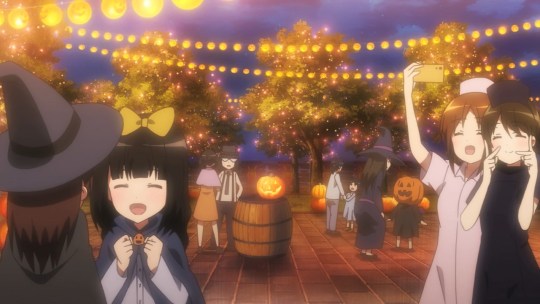
Cocoa thinks that Tippy speaking is an evidence of a ghost, despite her interacting with a real ghost just a few moments before. The 3 Lapins arrive and start arguing who is the real Lapin. Chino says that it’s the one who gets away with everything in the end, implying she will take the whole Cocoa for herself. However Sharo arrests Cocoa for making everyone worry.
On the way back, Chiya recalls the legend which was also mentioned by her grandmother at the beginning of the episode about the spirits of the ancestors coming back for this one day and then returning to heavens. Chino looks up to the sky, while Tippy gives her a solace in the fact that he was once again turned away, implying that he expected to return to heaven with the other spirits.

Tippy also seemed to know what Cocoa was talking about in an earlier scene where Cocoa said she forgot to give thanks to somebody. Just what’s up with Tippy and why is he not allowed to enter Heaven is a big mystery here.
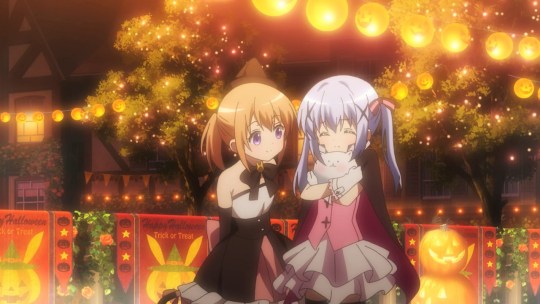
Cocoa also notices Chino being distressed and shows her the magic trick with the candy. It turns out Chino remembers this trick from her childhood, and we get to see a full flashback with Chino’s mother even getting a few speaking lines (delivered by none other but Nana Mizuki). Since the candy was probably a part of the magic set, it’s no coincidence that it has the exact same wrapper in the flashback. The color of the candy matches with Chino’s clothes at the time but you can also think of it as a combination of Saki’s white and Chino’s blue.

By the way, in the manga Cocoa conjures up two candies, and they have a plain wrapping so there wasn’t One Specific Candy like in the anime. Also in the flashback, Chino is carried by her grandfather. His face is not shown, but Takahiro is seen in the background (with Rize’s dad) so by exclusion it had to be him. And in the current scene Chino is the one carrying Tippy like this.
The episode ends with Cocoa asking Chino to tell her more about her mother, while a star is seen rising in the sky, presumably symbolizing Saki’s spirit.

Let’s go back to Cocoa meeting Saki scene one more time. Like I explained, it’s heavily implied that Cocoa isn’t really in the same world as the other characters when she meets Saki’s ghost. Of course Gochiusa had supernatural elements from the start, such as a certain talking rabbit who happens to be Chino’s grandfather. But now we have a ghost of Chino’s mother and Cocoa is the only one who can see her, but Chino can’t? Just what the heck is going on here?
But wait, there is a rational explanation for all of this! Cocoa had a hallucination triggered by all the Halloween celebrations. She imagines helping a lost child just like Chino did before (and told Cocoa about it later) and then imagines the ghost of Saki teaching her magic, because subconsciously she wants to be like Saki. She had seen Saki before on a photograph, but haven’t heard her speak, which is why the ghost can’t talk to her. Hearing Chino call her onee-chan brings Cocoa back to her senses. But how did Cocoa learn the trick if it was just her imagination? Well, consider the fact that she was practicing this exact trick at the beginning of the episode. By the time she shows it to Chino, she has already practiced it a lot of times, but maybe she only realized the crucial part (feint) during the hallucination. Either way, the blue striped candy wasn’t given to Cocoa by Saki, she had it from the start, as part of the magic set! The candies that Saki uses to show the trick to Cocoa all disappear when Cocoa returns to reality.
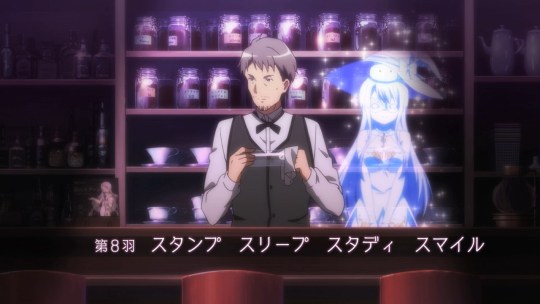
Saki appears one more time in the bar time scene with Takahiro, who is listening to her record Silver Spoon from Sing for You OVA and then calls her by name. I think this is the only time the name “Saki” is mentioned in the show itself, and it’s not mentioned in the manga at all (unless maybe in some recent chapters which I haven’t read yet). The first time it was revealed was during April Fool’s day Clockwork Rabbit event, as a solution to a “puzzle”. Her name is written in katakana as サキ, however one of possible readings of the word “saki” is 咲き which means “bloom”. Now consider how the last few seconds of the opening animation it cuts from a blooming field of dandelions to Saki:
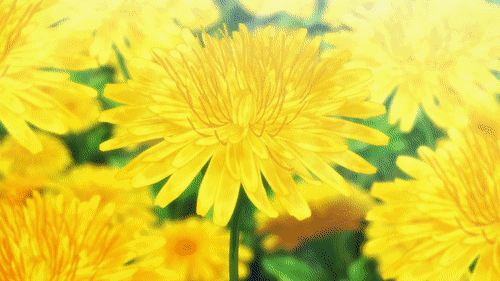
The dandelions connection to Saki was previously seen in season 2 episode 1 and Sing for You. Saki’s character design doesn’t really say “blooming of dandelions” to me, but consider that a dandelion turns into this:

Now that’s more like it! Although it reminds me of Tippy as well. Anyway, that was a very mysterious episode of Gochiusa BLOOM and let’s see what happens next! Only 5 episodes remain...
11 notes
·
View notes
Text
SOLAS & ORPHEUS I: YOUR NAME IS LIKE A MELODY. (THE POWER OF EPITHETS, TITLES, & NAMES.)
EPITHETS & TITLES:
VGS: Where do you see a character like Solas ending up? Patrick Weekes: [Sighs] Musical theatre.
The above exchange is from an interview with Video Game Sophistry, where Patrick Weekes goes into detail about the creation of Solas and how we ended up with the character and romance we got. Although said in jest, I do believe Weekes honestly recognised that Solas is a character who could easily be adapted to the medium of the stage musical, due to how musicality is baked into the foundations of his story and the world of Dragon Age. In fact, Weekes compares the fantasy and romance of Solavellan to The Phantom of the Opera earlier in the interview, and anyone familiar with Phantom can see the parallels, as Solas and his arc share many tropes and archetypes in common, not just with the Phantom, but with other male characters in musicals. If I told you I was going to see a show about a Morally Conflicted Soldier, a Trickster in Disguise, a Rebel Leader, a Decadent Noble, a Mythic Legend, or a Monster Boyfriend, I’m sure several examples would jump to mind.
Solas is all of these. Layer upon layer, stitched together, and then taken apart, whenever he needs to be whatever he needs to be. And he is also, if we are borrowing the epithets from Hadestown, The King and The Poor Boy Working on a Song.
It has to be noted that Hadestown’s use of epithets is itself a nod to ancient oral poetry, particularly in the vein of Homer. In Homeric convention, important characters, settings, and objects weren’t described by adjectives, but with epithets that would change based on context. (e.g. Much-enduring Odysseus, who is another paradoxical Trickster figure in ancient myth.) The use of epithets is a signifier of the origins of Homer’s works, serving as a mnemonic device and a way to fit the scenes of the stories to dactylic hexameter, as they were first oral poems that were composed and sung in front of audiences before they were written down. However, because of our modern understanding of the English language and what the word epithet connotes to us, what Anaïs Mitchell has done by using this device in Hadestown, is turn it into something that’s closer to the definition and function of a title rather than an adjective. Hades is always “The King.” Orpheus is always “The Poor Boy Working on a Song,” or “The Poor Boy With a Gift to Give.”
Solas bears his names in a similar fashion. When introduced to us as merely Solas, he is the “Humble Apostate” (or “Unwashed Apostate Hobo,” if you have Vivienne and Dorian in your party), or the “Fade Expert”; he is nicknamed “Chuckles” by Varric and “Fade Walker” by Iron Bull. Descriptors that comment on his lowly, outsider status, beaten and betrayed in this strange new world, that endear us to him. When he again dons the badge of Fen’Harel/Dread Wolf, he is “He Who Hunts Alone,” “Lord of Tricksters,” “The Great Wolf,” “Roamer of the Beyond,” and “Bringer of Nightmares.” Bynames that, of course, evoke those given to deities in ancient cultures (e.g. Hades is also known as Plouton in Greek myth, “The Rich One.”), that make him out to be fearsome, malevolent, and unknowable beyond the legends.
When I separate Solas into these two personas and archetypes, of Solas and Fen’Harel, The King and The Poor Boy, I don’t want us to make the mistake of thinking he is someone who bifurcates himself so completely that one part of him is unrecognisable from the other. His is not a situation of one identity hiding another or two identities battling to control the fore. He is Solas and he is Fen’Harel; the way Lavellan is “The Dalish Elf” and “The Herald of Andraste.” He is simply someone who has some impressive compartmentalisation skills (displayed in a conversation he has with Sera on the tactics of the Red Jenny group), and who has a thorough experience of a line he says to Cole:
“We all have a face we want to show, and a face we do not.”
NAMES:
Perhaps the best way to convey Solas’ complexities coming together to form the whole of him, is by examining the construction of his name. How cyclical it is, beginning and ending with the letter S, as effortlessly smooth and slippery as he. The L in the middle like a delineation, a fork in the road of choices before him. O and A on either end like they’re mirrors or masks. How it’s composed of five letters, the way iambic pentameter is composed of five syllables that you must stress and unstress—like the two syllables in his name itself. And depending on which syllable you stress in your pronunciation, your voice will either rise and fall or fall and rise when you say it.
I may be giving Gaider and Weekes too much credit here, but Solas’ name is quite literally perfect for him. Change any single one of these components or his characteristics, and you will no longer have Solas but someone else in his stead.
There are layered meanings to the sound of his name, too. Solas is a homophone for Solace and Soulless in the English language. The former recalls all the times he might’ve provided solace to his friends or lover, or received it from them; and the latter recalls how he does seemingly soulless things to achieve his goals, or becomes someone who is soulless altogether if you don’t reach out to him with kindness. Angela D. Mitchell explores this wonderfully on her blog Dumped, Drunk and Dalish, along with homonyms in other languages. Among them are:
Latin: Solus Meanings: Solitary, alone, sole, only, uninhabited.
Irish: Solas Meanings: Light, Bright, Clear; Brightness; illumination; lucid, intelligible; light-giving, lamp flame; enlightenment, insight; revelation, disclosure; the light of existence; vision. Also: self-interest; limelight.
Old Irish: Solus Meaning: Light.
Scottish Gaelic (derived from the old Irish "Solus" or "light"): Solas Meaning: Light.
Old French: Solaz, Sollas, Soulas Meanings: Joy, pleasure, enjoyment.
She also explores the Latin root of ‘Sol’:
Lone, alone, solitary, lonely, desolate, dismal, gloomy The sun (also can refer to the Sun in a personified sense) A source of comfort, calmness, soothing "To be accustomed" (as found in such words as: insolent, obsolescent, sullen)
These are all such apt descriptors for various facets of his personality and story, it shows the amount of thought and care given to him in the writing process. And of course, there are the Elven meanings: ‘Pride’ or ‘to stand tall.’
Because of the level of thought involved, I wondered how far back Gaider chose his name and decided it would mean ‘Pride’ in Elven, and how that might’ve informed Weekes’ writing of his character. @maythedreadwolftakeyou, @felassan and @lesbianarcana (my heroes!) helped me out and did some top-notch digging.
The first instance we have of the word Solas was found in a codex acquired from Dragon Age II’s Black Emporium, which was released on March 8, 2011. After that, it appears with its Elven meaning and on a map in World of Thedas Volume 1, released on April 30, 2013.
Since we have an enormous amount of foreshadowing for him by way of Shartan in Dragon Age: Origins and Merrill in Dragon Age II, I think it’s safe to say the first concepts of what Solas would mean and who the character who would wear the name would become began as far back as DAO. (Note: I believe Gaider or another Bioware dev confirmed this on social media, but I couldn’t find the post anywhere. If it crops up and you see it, please let me know. I’ll amend the post and credit you.)
In any case, the power of names is yet another running theme that links the storytelling of the ancients, Hadestown, and DA:I. Orpheus pays attention to the composition of Eurydice’s name, and remarks on how it’s “like a melody,” and his arrival in Hadestown reminds her of it when she’s been stripped of it and has forgotten who she used to be. Solas tells Abelas he hopes that he finds a new name after he leaves the guard of the Vir Abelasan, because it means Sorrow. The Qunari in Tevinter Night’s Genitivi Dies in the End have a special interest in finding out what they believe to be Solas’ “true name,” so they can then “track [him] back through the best and worst of [himself]”; “find flaws”; “exploit weaknesses”; “know what [he] failed to be.”
To be named is to be given an identity, personality, and, in most cases, personhood. To be named yourself and to be able to name others is power. Whether that comes as the name you’re privately called, your title, or your epithet.
#da meta#dai meta#solas meta#dragon age meta#mine.#text post.#of a god & man: solas & hadestown meta series.#dragon age.#solas.#hadestown.#this was A Lot to write#spoilers for tevinter nights!!
55 notes
·
View notes
Text
10x22: Here’s Negan - Details
All right. Here are a LOT of details.
***As always, spoilers abound below for 10x22. Don’t read until you’ve watched!***
We start with Maggie and Hershel walking around Alexandria early in the morning. She calls him “a little rat” affectionately, which I’m side eying. Because of Carol’s rat last episode and because we already established parallels between Hershel and Beth from ep 17 in that he went missing and Maggie and Daryl searched for him.

Then they sing “you are my sunshine” together, which is the same song Carl sang Negan. Because the sun is a Beth symbol, we’ve always seen her in that song. I also wonder if it foreshadows Maggie losing Hershel in some way. I don’t mean him dying, but rather being kidnapped. A lot of us have thought about one or some of the kids being taken at some point, and their parents having to search for them.
Carol looks out a broken window (Broken Glass Theory) and sees the exchange. So, she leaves Alexandria and takes Negan with her.
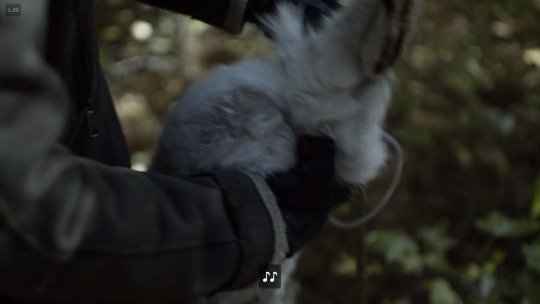
Actually, the next thing we see is a dead rabbit she pulls from a snare. The rabbit is SUPER interesting. I answered an Ask HERE about the moon rabbit, and I really love this explanation of the symbol. It makes perfect sense for Beth because the moon rabbit sacrificed itself, which is exactly what Father Gabriel said cryptically in 5x16. “How you sacrificed one of your own….”
Plus the Moon rabbit is resurrected and combines the moon symbol and the rabbit symbol.
So what does it mean in this context?
Well, I still don’t want to go into too much detail, though I will soon. (I promise.) But if rabbit = Beth, I think this is yet another example of symbolism that points to Negan and Beth having a big arc together later. (And Carol will probably be thrown into the mix.)
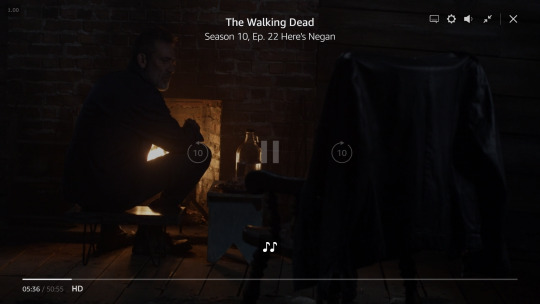
That evening, Negan drinks by the fire. What he’s drinking is clearly moonshine. It’s from one of those big glass moonshine bottles. I don’t know where he got it. I looked a second time at the stuff they left for him, and it might be in there, but if so, it isn’t visible. It would certainly be interesting if Daryl left him moonshine, but I don’t see any super-obvious hint at that. If it’s already there in the cabin, well, that’s Leah’s cabin, so….
This is where he sees his old self from the trailer. Some of the dialogue jumps out at me as things Daryl might say about himself. Evil Negan says to his good self, “You are nothing without her.” That sort of thing.
The next day he goes back to the tree with the stained-glass windows where Rick cut his throat. One of the plate glass windows has a hole in it and the other one is lying on the ground.
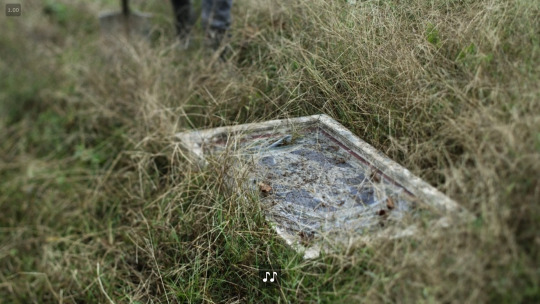
My go-to explanation of course is that the one with the hole represents the bullet hole in Beth’s head. (We actually said this of the stained-glass window in Father Gabriel’s church that Sasha shoots a hole in in 5x16 as well.) And I always see someone falling down as a serious injury. So, when Beth belly-flopped in the elevator shaft with Noah, that was a foreshadow of her getting shot. So I’m kind of seeing the window lying flat on the ground in the same way.
Of course, Negan digs up Lucille, and then it goes into the flashbacks.
It starts of course with him being a prisoner of the biker gang. We do think this gang is a parallel of the Claimers from S4. Remember that I said, overall, Negan = Daryl, right? So, this guy (Craven) even kind of looks like Joe Claimer. They dress in a similar fashion, are rough-and-tumble kind of dudes. But also, Negan runs into them after he loses Lucille. He doesn’t realize she’s died at that point, but she has. Just like Daryl ran into the Claimers after being separated from Beth in Alone.

And we immediately see a blue cooler with IV bags inside. They’re Lucille’s chemo treatments. So blue cooler/Frosty Cola symbolism. Plus this can parallel to 6x06 when Daryl accidentally took off with Tina’s medicine when he met Dwight. Basically, these are both pointing to the same thing: a future arc involving Daryl and Beth. There are also 22s on the IV bags. So, 22 theory.
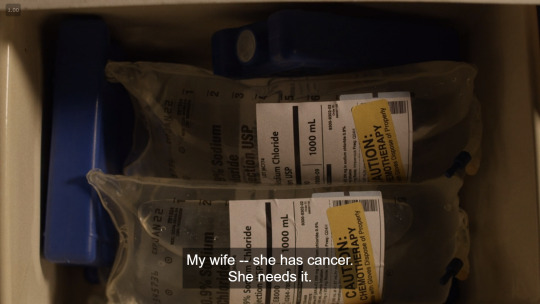
I will say that the format of this episode is a lot like 10x18 because so much of it is flashback. They even use the same font to show the time jumps. The main difference is that with Daryl, they started 5 years ago and then jumped forward, toward the present. Here, they actually move backward first and then forward again.
So it’s like a swinging pendulum. They go back 12 years to where he’s a prisoner of the bikers. Then it goes back 6 weeks to when he’s with Lucille in their home , and then it jumps back again to before the apocalypse when she first found out she had cancer, which was right about the time the turn happened. And then it moves forward to the two of them together in the house, and then back to him with the bikers.
Okay, so, “12 Years Ago” he’s telling his story to the bikers.
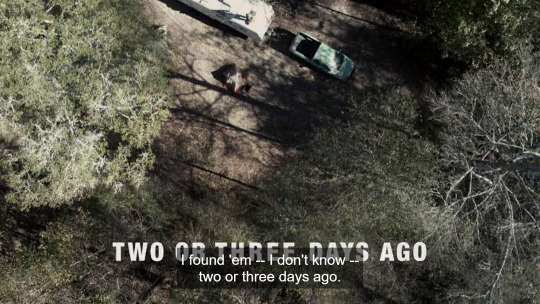
Then it actually says “Two or Three Days Ago” and it’s odd to me that they don’t specify which one it is. Negan says he found the mobile medical clinic 2 or 3 days ago, but there’s got to be a reason they don’t just go with one or the other. Anyway, this is when he found an RV with supplies. He tries to hold the doctor up and Laura (Savior) comes up behind him with a bat and hits him.
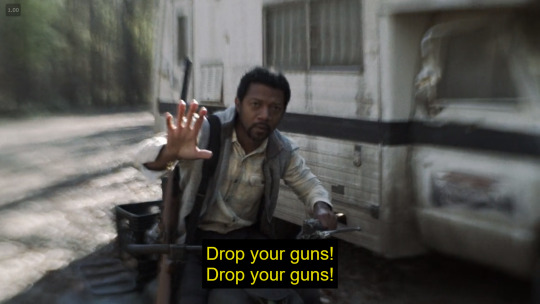
We also get a bit of a hallucination theme. When Negan looks at the RV and the dummy guards on the roof, his sight sort of warps in and out like he can’t tell for sure. When he wakes up, he’s also hooked to an IV. (Parallel to Beth at Grady.) The doctor says he was dehydrated, malnourished, and exhausted. So maybe, in addition to all the mental break stuff we’ve already said about Daryl in 10x18, we should add these to the list.
“Six Weeks Earlier” and it shows him and Lucille. The first thing we see is that she tells him he’ll have to kill the walker but he doesn’t want to. He just turns off the generator, hoping it will go.
So, she makes him read Pride and Prejudice to her. The Pride and Prejudice thing is really interesting. He only reads a line or two, but anyone familiar with the story will be able to pick out the scene. Basically, in the story, a man asks Lizzie to marry him and she rejects him. He doesn’t love her or anything. He’s just looking for a “suitable” wife, and she can’t stand him. After she rejects him, her best friend marries him instead. And this friend doesn’t care that it’s not a love match. She just wants to be settled in life.
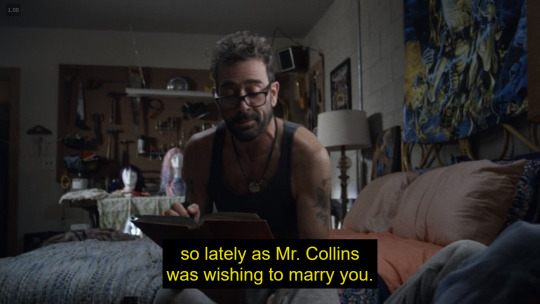
So the scene Negan reads part of is where the friend, Charlotte, is coming to tell Lizzie that she’s marrying him instead. This is the part Negan reads:
"I see what you are feeling," replied Charlotte. "You must be surprised, very much surprised--so lately as Mr. Collins was wishing to marry you. But when you have had time to think it over…”
Here’s the thing. No way they’re putting dialogue from such a well-known book like this into the show without reason. And I know they said on TTD that it’s supposed to be an Easter Egg for Pride and Prejudice and Zombies. Fair enough, but it’s not enough of an explanation for me. In the past, there have been things Nicotero has labelled as homages to various horror films, and I’m sure that’s true, but they’re also clearly Beth symbolism.
So, you could say that Pride and Prejudice and Zombies applies to Negan and Lucille. It’s a true love story, but zombies are thrown in. That works. But why this particular passage? It’s about NOT marrying for love, or the passing of a man’s offer of marriage from one woman to another. None of that applies to Negan and Lucille. It would have made more sense to have him read a different passage between Lizzie and Darcy, you know?
So, what does this mean? We’re not entirely sure, yet. For me, I tend to think it foreshadows a future arc (I’m sure you’re shocked) and I’ll get more into that in the next few days.
@wdway suggested perhaps we could apply it to the Leah situation. Daryl is in love with one woman, but hallucinating a relationship with another. I think that works, too. For now, let’s just keep it in mind, shall we? ;D
Dialogue parallels include Lucille saying, “we’ll have to kill it,” which parallels Beth saying the same thing about the walker at the moonshine shack.
And of course then we get that all important scene with the green wig, “serious” mention, IV stand and bag, and walker in the eye.
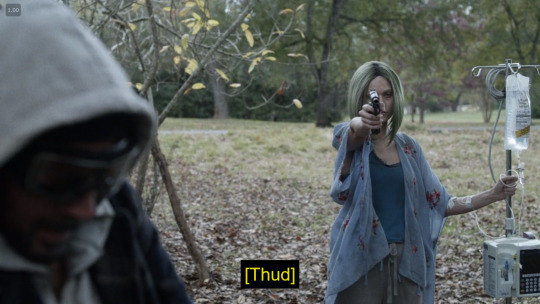
We see Negan going out to look for more gas for the generator, siphoning it out of cars.
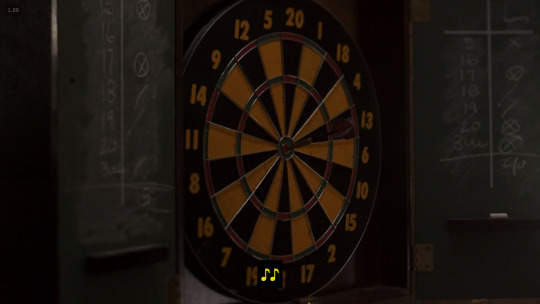
We also see them having fun together. Obviously them playing darts is a callback to Still. The part where they play darts is actually just like half a second in the show, which just goes to show that they did the promo shot because they wanted us to see the symbols in the scene. I want to draw everyone’s attention to the fact that the British flag is printed on the darts. This is part of the template I’ll talk about in a day or two as well. For now, I just want you to notice it. It’s important.
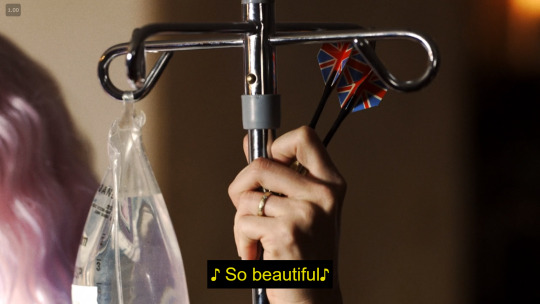
When they do the candlelight dinner (*coughs alone*) they eat DOG food. Sirius reference. She suddenly says “happy anniversary” and pulls out a present for him. He says, “You know what day it is?” and she says, “no, I just wanted you to have this.” So I think the idea is that it’s not really their anniversary. She just said that as an excuse to give him a present. It reminded me a little of the “New Years Eve” theme we saw around the Claimers. Not exactly the same, but a similar vibe. It’s not REALLY New Year’s Eve. They’re just saying it as an excuse to do something else (in that case, kill Rick). Here, it’s not really their anniversary, but Lucille is saying that as an excuse to give him the jacket.
When Negan says she doesn’t owe him anything Lucille says, “I stuck with you because I could always see the man you are right now, even when you weren’t.” So again, kind of a Beth theme of seeing the best in him even when he doesn’t see it in himself. That’s a huge theme throughout this episode.
There’s more refrigerator/cooler symbolism when the fridge defrosts, ruining the last of Lucille’s treatments.
Then it jumps back to before the apocalypse. There were some symbols here as well. The main ones I noticed were specifically around Lucille. After her diagnosis, she gets in the car and hears the broadcast about the virus victims eating human flesh. Kind of a callback to hearing the Terminus broadcast in 4a.
Then she gets mad and says, just play some g**d*** music. (Music reference.) When the car pulls out, you have to check out this license plate!
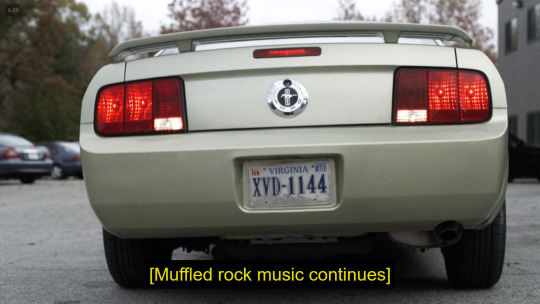
XVD-1144. The 1-1 you should recognize from @frangipanilove’s 1-1 posts. The 44 references the comic book issue where Andrea was shot in the head, and survived. And of course there’s the X. So then @wdway had the ingenious idea to ask what roman numerals X and D stood for. X=5 and D=500. So we basically have “X, 550, 1-1, 44.” Yeah, series number 55 was Slabtown. Beth was on the 5th floor. And all the rooms around them in the hallway at Grady were in the 550s. If that’s not proof that Lucille is a Beth proxy, I don’t know what is.
Plus, notice the type of car: mustang. We’ve talked about this before, but horse symbolism, and the type of car is always important.
Another thing @wdway with her eagle eyes picked up. Lucille is scrolling back and forth between Negan and Janine’s numbers, right? Notice the date:
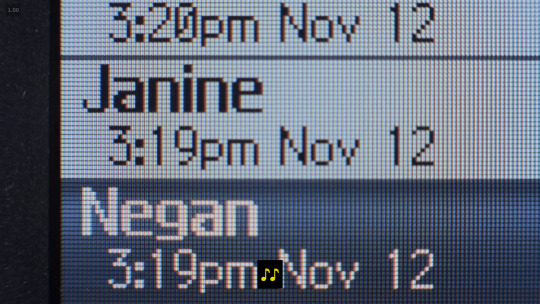
November 12. Recognize that:

Yeah, not kidding. It’s a reference to the headstone in Alone. 👀
Back in the future again, Lucille asks Negan to stay with her. You don’t realize this the first time watching it, but clearly she’s ready to die, and just wants him to be with her, but he’s bound and determined to save her, an goes anyway.
A couple of things to point out. Negan looking for meds parallels to Daryl looking for meds at the veterinary college in 4a. Also, on TTD they pointed out that Negan is constantly putting Lucille in a position to be alone. Before the apocalypse, he left her alone to fool around with another woman, who was her best friend. He made her go to the doctor alone. (Lucille alone at the hospital could = Beth at Grady.) We see him constantly leaving her here to get supplies. And he leaves for like 6 six weeks to track the mobile clinic.
I think that’s mostly an anti-parallel to Daryl. Daryl never left Beth intentionally. But I also think it could be a future theme, not in the sense that Daryl will leave her, but I’ve always thought he would feel super guilty because they left her behind and now she’s been “alone” for 8 years. And again, not physically alone as we know she’ll be part of other groups and such, but without him and her family.
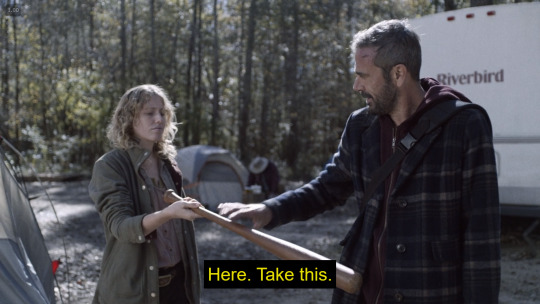
Back with the medical people again, Laura gives Negan her bat, the one she first beaned him with, since he doesn’t have any other weapons.
All they said about Laura on TTD was that they wanted to use her—someone the audience would recognize—but also someone who had a relatively minor role. So they talked about how they could have brought Austin Amelio on and had Dwight give it to him, but because Dwight is a bigger character, and because his onscreen relationship with Negan was much bigger, it would have made it a Negan/Dwight moment and they wanted to keep this episode focused solely on Negan and Lucille. So they used Laura.
And sure, that’s fine. But they could have used any Savior they wanted. And why did they even WANT a familiar face? Why the return of the Savior with the blond hair, you know? I’m just saying. ;D
Of course Negan tells the biker gang where the medical RV is and then goes back to Lucille, but she’s already dead. This really was a very tragic episode.
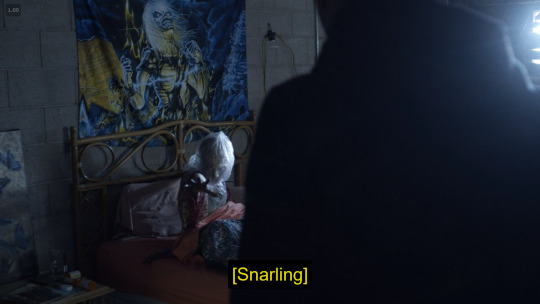
We obviously have a suicide theme here, and the fact that Negan never actually shoots or stabs Lucille in the head, both of which parallel Beth.
On TTD, YNB even pointed out that she’s wearing the same clothes as she was the day he left, which means she committed suicide the day he left. Most of the 6 weeks he’s been out looking for medical supplies, she was already dead. Super tragic, no?
We also see keys, matches, the blue cooler again, and Negan wrapping the barbed wire around his bat.
So, a couple of preliminary thoughts here. The 6 weeks was bugging me because they said it 2 or 3 times, really emphasizing it. I’m kind of wanting to equate it to 6 seasons. Because if Beth doesn’t show until S11 (and clearly now she can’t, unless she shows in Fear or something, but I’m not holding my breath for that) then it will be 6 seasons since Beth left the show.
And again, it’s more anti-parallel than parallel. For 6 weeks, Negan thought Lucille was alive, but she was dead the entire time. For 6 seasons, Daryl thought Beth was dead, when really she’s been alive the whole time.
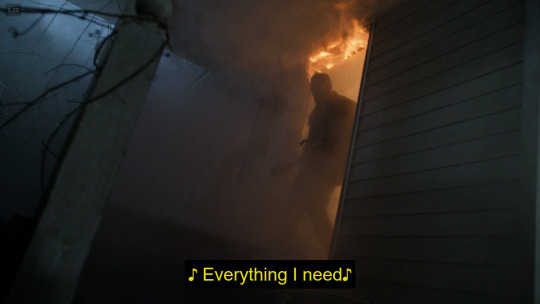
And, of course, Negan burns the house down, much like Beth and Daryl did in Still.
But here’s the other thing @wdway noticed. Check out the similarities here:
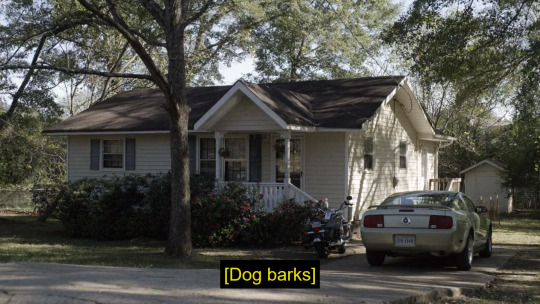

Similar colors and structures, and both seem to be on fire at some point. And I don’t think the cabin in 5x09 was pointing toward Negan and Lucille. Rather, I think the symbolism in both instances point toward something we haven’t seen, yet. But the parallels and repeated symbolism are there.
When Negan leaves, he gets on his bike with Lucille (the bat) and drives away from the burning house. And interestingly, we see him smack his mailbox with it and knock it off it’s post.

Couple of things here:
The name “Smith” is written on the mailbox, so apparently that was their last name. And they mentioned it on TTD. Smith is such an everyman sort of name. It might be one of the most common surnames on the planet, so there’s definitely some interesting symbolism there having to do with Negan.
But I’m side-eyeing the actual mailbox, as part of the Communication Theme. And, on a very basic level, I’m thinking that the mailbox was intact when Lucille was still alive. He destroyed it after he lost her. So maybe it represents something along those lines, or even represents the person they lost. So mailbox = Beth.
The scene that keeps flashing in my head is from 6x03 when Daryl is riding around on his bike, searching for Rick, and he’s passing all these mailboxes in the background.

Then in 10x21, we see him walking toward the military walker on the train tracks (*coughs CRM, *coughs Rick*) and he passes the blond, Beth walker, but doesn’t actually look at her or see her. Do you kind of see the similar theme there?
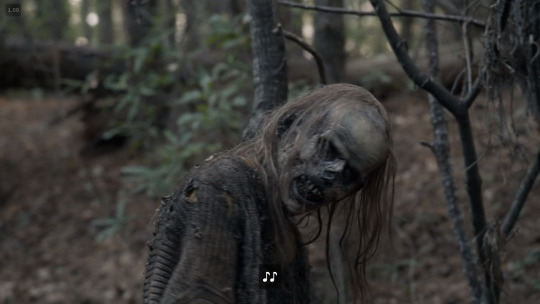
Negan brutally killing the biker gang can parallel Rick doing the same to Joe Claimer in 4x16.
Negan tells Craven a story about how he lost his job. He got in a bar fight. It was their favorite because it had a JUKE BOX. And they loved the juke box because it played their favorite song (You are So Beautiful to Me.) He even talks about “seeing red” and how he now realizes he can do anything he wants (read: kill anyone he wants) so we kind of see his evolution into S6 Negan here.
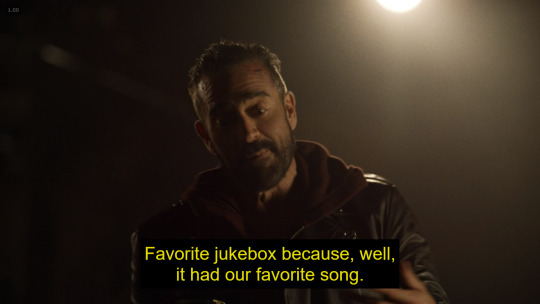
And honestly, they leave a lot of loose threads here. We never learn what happens to Franklin (he’s still alive at this point) and obviously Laura stays with Negan long term, but they really could do more flashbacks about how he started gathering people and found the Sanctuary.
So then we come back to the present where he’s just dug Lucille up under the stained glass window tree. In the first scene at the beginning, we see a walker making its way toward him. Yes, it’s a blond, female walker, and I’m pretty sure she’s wearing Daryl’s shirt from when he was at the Sanctuary. Here at the end, Negan has been lost in his own thoughts so long, the walker comes up behind him and he turns around and kills it with Lucille.
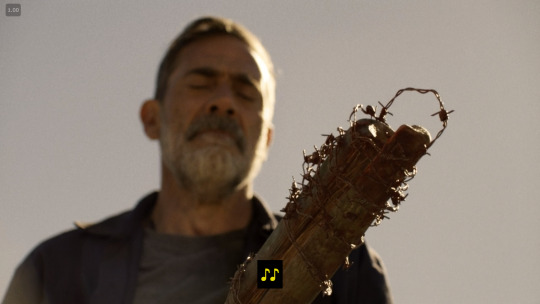
When he does, the bat splits down the middle. Yet another symbol of Lucille’s death.
He goes back to the cabin and sits in front of the fire and talks to Lucille (both the bat and his actual wife). He says, “I’m sorry I left you…I made myself not feel anything…I miss you.” See how we could apply that to Daryl?
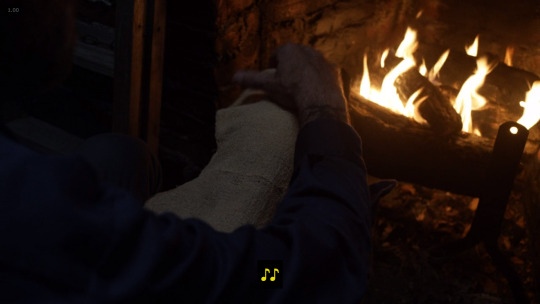
He also says, “I’m going to do your fighting for you,” which I take to mean he’ll honor her memory better, now, rather than go back to the old, evil Negan he was. Which was really just years of him avoiding his feelings about her death. (Kind of like Daryl has with Beth, hence the Leah situation.)
Then he covers the bat in a white cloth (clearly meant to be a shroud) and puts the bat in the fireplace, burning it. On TTD, they do say this is meant to be the funeral she never got. 👀
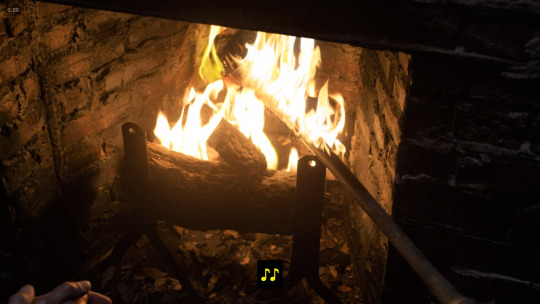
Oh, and at the end of the “in memoriam” on TTD, it actually says, “Negan is burning down his past.”
So, at the very end, he actually goes back to Alexandria. Maggie, Carol, and Daryl are near the entrance and he asks where the “A” team is going. Carol warns Negan that if he lives at Alexandria, Maggie will kill him at some point. I actually really liked this ending. It was a good way to kick us into S11.

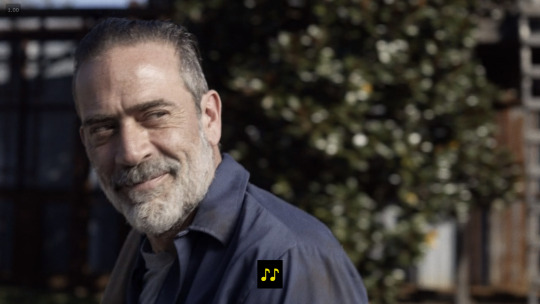
That’s the end of the episode. So, I’ll say this again and it will be a good segue into my next post about what I think Beth’s arc will be in S11, and how she’ll appear. I’ll post it either tomorrow or Thursday.
Without getting too much into the weeds, I think Negan and Beth will have some major, future interaction. And I really think the symbolism here backs it up, for various reasons. The symbolism itself wouldn’t prove anything, as we’ve seen this stuff repeated with lots of different characters and especially true love couples, which Negan and Lucille clearly were, despite his cheating.
But on TTD, Hilarie Burton talked about how strong Lucille was. She said she liked the character because so often when cancer victims or victims of other prolonged diseases are portrayed on film, they’re seen as angelic, ethereal beings. And while that’s fine if that’s truly who they are, you don’t lose your personality just because you become sick. So she liked it that Lucille was a little rough around the edges. She says that even before the apocalypse, Negan was just fussy enough that he would need a strong woman to rein him in, and he would also be attracted to exactly this kind of strong woman.
Strong woman = Beth.
So, I’ll just leave it there.
Anyone find any symbols I missed?
#beth greene#beth greene lives#beth is alive#beth is coming#td theory#td theories#team delusional#team defiance#beth is almost here#bethyl
18 notes
·
View notes